
|
|
The Clan 0.9 cc Diesel
So why the need for this second article, you understandably ask?!? To encourage continued reference to the now-frozen but still invaluable MEN site, thus maintaining its visibility, my policy in developing my own site has generally been to avoid duplication of material already on MEN, linking to that material instead. Isn't this a violation of that policy? Well, not really...... historical research never ends, and the record is always changing as knowledge expands. For this reason, I have never hesitated to publish updated articles on a subject already covered on MEN in cases where a significant body of new or corrected information has become available. To do otherwise would be to leave the historical record rightly or wrongly frozen forever at the point at which Ron so tragically left us. That was not what Ron wanted! This is a case in point. Although Ron’s original article included some basic background material on the Clan 0.9 cc series in general, its primary focus was on the construction of a superb replica of the first variant of the engine by the very talented model engine constructor Graham Podd. This made very interesting reading, which remains well worth a look today. However, the coverage of the second variant was rather less complete, nor were any test figures generated for public Accordingly, the following text will not delve into the construction aspects of the first (and in some ways more interesting) variant at all – Ron has already done that. Rather, the primary focus here will be upon an examination and test of the second variant of the engine, an example of which I was fortunate enough to acquire in 2015. In researching the material to be presented here, I had more than a little help from others! Firstly, I'm greatly indebted to my late English friend Paul Rossiter for drawing my attention to the availability of the example of the Clan which I was subsequently able to acquire. Secondly, I'm greatly beholden to my valued Scots friend and colleague Don Imrie for tracking down some of the more obscure elements of this story. And finally, I was fortunate enough to secure the invaluable assistance of my Aussie mate Maris Dislers, who once again trolled through his collection of old model magazines to ferret out a number of advertising placements relating to the Clan marque. Without help such as this, I wouldn't get very far with these articles! Whenever we talk about the Clan engi It scarcely seems necessary to point out (but I'll do it anyway!) that these were completely unrelated to the original Clan engines from Fife in Scotland! The Fife-based company never made any engines of that tiny displacement. Further information on the Clanford Clan may be found in another Ron Chernich article which is still available on MEN. In addition, a full review and test of the engine by Maris Dislers may be found elsewhere on this website. The balance of the present article will be strictly confined to the engines produced in Scotland during the late 1940’s. For the convenience of readers new to the marque, I'll briefly summarize the main points of the Clan story, after which I’ll deal with a few unsubstantiated "legends" which have somehow persisted over the years. Once that's done, I'll proceed to the main task - an examination and test of my new acquisition. First, the background……. Background During the years immediately following the conclusion of WW2, a considerable pent-up demand for model engines existed in Britain, both as a result of a natural post-war desire to resume peace-time hobbies and on account of the novelty appeal of model engines during those early post-war years. Although the cost of such engines was significant in the context of the cash-starved British post-war economy, their novelty value encouraged people to save up and buy them anyway. Engines were in relatively short supply at the time In response to this demand, a significant number of small-scale “cottage industry” model engine manufacturers quickly began to appear in early post-war Britain, some of them working quite literally in the proverbial garden shed. The names of Healy, Kemp, Leesil, Reeves, M.E.C., Comet, Ace, Dyne, Wilsco and Milford spring immediately to mind, and there were others. Indeed, there were almost certainly a number of such small-scale “artisan” operations whose names are now lost to us. It appears almost certain that the development and manufacture of the Clan engines was another small-scale venture which was initiated in response to the above market conditions. The Clan engines were made by a small company called Kingdom Models, which initially dispensed with the garden shed in favour of the use of a production facility housed in a converted cowshed! This facility was reportedly located in the descriptively-named former coal-mining community of Coaltown of Wemyss in Fife, Scotland.
Following the original publication of this article, my valued Scots friend and colleague Don Imrie embarked on a determined effort to identify the precise location of the workshop in which the Clan engines were made. He began with the anecdotal evidence of a contemporary 1948 visitor to the workshop to the effect that it was then located at Coaltown of Wemyss.
Amazingly enough, portions of the former Claymore Works facility at Thornton still survived as of 2022, albeit in a derelict state. The lintel of the green door of the former office complex (left in the accompanying photo) still proudly proclaimed that it led into the "OFFICE"! The main factory was taken up by the roofless area to the right of the office block, but only one wall still stands.
Fur As far as the media record shows, the Clan engines were marketed in their native Scotland by a company called Clan Models, who gave their address as 24 First Avenue in Glasgow. To confuse the issue somewhat, Clan Models also had a sales outlet at Leven in Fife quite literally just a few steps up the road from both Coaltown of Wemyss and Thornton where the Clan engines were actually manufactured. It would appear that the Glasgow address was that of an agent for Clan Models serving the western side of the Scottish lowlands. All of this makes it appear likely that the Clan Models trade-name was applied by Kingdom Models to their own products and that the Leven address was their primary sales outlet. The Caledonia Model Co. Connection
There are a number of reasons for my present doubts regarding this identification. First, the initial pre-production announcement of the Clansman 5 cc diesel and its 5 cc Falcon spark ignition companion took the form of an advertisement placed by the Caledonia Model Co. in the June 1946 issue of "Aeromodeller". In that advertisement, both engines were referred to simply as forthcoming "Caledonia" products - the model names had evidently yet to be chosen. The key thing to note is that there was no mention of the Clan name. More to the point, the engines were specifically referred to as "the Clyde-built super engines". Coaltown of Wemyss is a very long way from the Clyde! This sounds far more like a preliminary Indeed, the Caledonia Model Co. soon began to refer to themselves in their advertising first as "Model Aircraft Specialists and Engineers" and later as "Model and Precision Engineers", implying a direct involvement with the precision engineering side. What appears to me to be the clincher is the fact that a surviving original engineering drawing of the Clansman and its components is clearly identified with the name of the Caledonia Model Co.of 5 Pitt Street, Glasgow. No mention of either Clan Models or Kingdom Models there ..........
By contrast, when Caledonia began to promote the Clan 0.9 cc diesel in mid 1947 along with the Clansman (the spark-ignition Falcon disappeared in very short order), the company invariably promoted the Clan product by that brand name, using the 0.9 cc displacement as the sole model identification and never presenting it as a "house" model. It thus appears that as far as the Caledonia Model Co. was concerned, there was a clear distinction - their sense of ownership of the Clansman far outweighed that which they felt for the little Clan. If the Clan 0.9 cc model did share a common origin with the Clansman, surely it would have been presented at the same level in Caledonia's advertising as a companion model in the same range? Why promote one model from the same manufacturer on a different footing from the other? In particular, if they were in fact directly related, surely the same brand name would have been applied to both of them? In that case, the larger engine would have been referred to as the Clan Clansman. Moreover, why wouldn't the little Clan 0.9 cc model have been given a similar name - perhaps the Clan Claymore or some such appellation? It has been argued that the name Clan was simply the name of the 0.9 cc companion to the 5 cc Clansman from the same manufacturer. However, if that was the case then it becomes necessary to explain why a distinct marketing entity (Clan Models, as opposed to Clansman Models) was set up at an entirely separate address to market the Clan 0.9 cc model but not the Clansman. Why not simply market both engines on an equal footing through the Caledonia Model Co.? This also begs the question of why the Astral Aero Model Co. (see below) didn't take on the Clansman when they became the English marketing agents for the Clan 0.9 cc model in mid 1947. All of this looks far more like two different manufacturers making their own arrangements for the promotion and distribution of their own products. In my view, Caledonia were more than likely involved with the Clan simply as a dealer rather than as a manufacturer, in contrast to their seemingly proprietory relationship with the Clansman and Falcon.
The Glasgow address of this company at 24 First Avenue was quite distinct from that of the Caledonia Model Co., which was not mentioned at all by either Astral or Sparey. If the source of both of those engines was either Caledonia or Clan Models, surely either the Astral advertisements or Sparey's summary (or both) would have said as much? As it was, Sparey treated the Clansman and the Clan as quite distinct and unconnected products, as did the Caledonia Model Co.. All of this casts considerable doubt upon the identification of Kingdom Models as the manufacturers of the Clansman and Falcon engines. It seems far more likely (to me at least) that the Clansman was made in Glasgow either by or for the Caledonia Model Co. The fact that Clan Models maintained a distinct Glasgow address seems to me to prove that there was no direct organizational connection between Clan Models and Caledonia - they were actually distinct manufacturers. However, we can't rule out the possibility that the Caledonia models were made by Kingdom Models under a contract to the Caledonia Model Co. which did not encompass the Clan 0.9 cc model, leaving that model to be promoted separately by Kingdom Models themselves, trading as Clan Models. A somewhat clumsy division of effort if so, but not beyond the bounds of possibility. If true, this would mean that the "Clyde-built" appellation applied to the Caledonia models would have been a public relations smokescreen, but higher levels of chicanery are on record! Thankfully, some clarification came after the initial publication of this article when I heard from my previously-mentioned Scots friend and fellow Clan owner Don Imrie, who lives near Coaltown of Wemyss. Born in 1944, Don was brought up in Glasgow and knew the Caledonia Model Co. quite well, first at the Pitt Street location and then later after owner George Leask moved it into much larger premises nearby on Argyle Street in 1960. Don reminded me that George Leask was one of the founding fathers of the Scottish Aeromodellers Association, Amazingly enough, Don still retained a sheet of the wrapping paper used by the Caledonia Model Co. following the move to Argyll Street! This states very clearly that the company's "works" were located at Cambuslang, a south-eastern suburb of Greater Glasgow. No mention of any location in Fife. Don recalls that a large Hoover factory was sited at Cambuslang, making it possible that some Caledonia components were produced there "on the side". However, it seems more likely that Caledonia had their own separate workshop at Cambuslang. Whatever the truth, this location is certainly consistent with the company's "Clyde-built" characterisation of the Caledonia engines. For me at least, this appears to settle the matter. Before I move into the detailed discussion of the Clan 0.9 cc model, I should close the books on the Clansman. My good friend Miles Patience acquired a nice example of this engine and was kind enough to run some tests on it for me. Miles' video of his example running may be viewed here. The engine was found to be timed for reverse operation, i.e., clockwise viewed from the front. Accordingly, pusher props had to be used for test running. The Clansman turned an APC 14x6 pusher at 3,890 rpm, an APC 13x6 pusher at 5,090 rpm and an APC 12x6 pusher at 5,260 rpm. The very small gap between the 13x6 and 12x6 props implies that the engine had peaked at around 5,000 rpm, at which speed it was developing some 0.140 BHP. This is about what I would have expected from this engine. My sincere thanks to Miles for sharing this information with us! Now, on to the Clan 0.9 cc model .............. The Clan 0.9 cc Diesel - Marketing History
Despite its seeming complexity, the system worked very well, hence being used in a number of WW2-era and early post-war model diesels before being universally supplanted by the less complex and more convenient contra piston and comp screw arrangement. A full discussion of the eccentric bushing system will be found in my separate article on the Thermite 34 diesel from the USA. The statement that the eccentric bushing variant of the Clan 0.9 cc diesel appeared first is well supported by the fact that it was this version which was mentioned by Lawrence Sparey (writing as "Artifex") in his previously-cited “British Diesel Summary” which appeared in the May 1947 issue of “Aeromodeller” magazine. Allowing for Editorial lead time, the engine must have been in existence by March 1947 at the latest to have been included in that article. That said, I'm presently unaware of any advertising promoting this variant in any of the British modelling magazines of the day. This version was also featured by Col. C. E. Bowden in the first edition of his book "Diesel Model Engines", which appeared (as near as can be determined) in September of 1947. The illustration at the right is extracted from that work. In his text, the Colonel stated that at his time of writing (mid 1947) the Clan 0.9 cc diesel was “undergoing alteration to facilitate production”. This must surely refer to the replacement of the eccentric At some point prior to the appearance of the resulting second variant of the engine in August 1947, the Clan promoters reached an agreement with the well-established Astral Aero Model Company of Leeds in Yorkshire, England under which Astral assumed responsibility for marketing the engines in England and Wales. Astral also acted as the export agents for the range. Clearly the manufacturers had high hopes of a wider market for their little powerplant! The second variant of the engine, and the one which will be evaluated in the balance of this article, was a basically conventional sideport diesel of its era, albeit with a few design features which set it apart. Astral's first national advertisement for the engine in this form appeared in September of 1947, seemingly confirming its position in the Clan design sequence and assigning its introductory date to around August 1947. This fits well with the previously-noted statement from Col. Bowden. That initial advertisement was placed in “Aeromodeller” magazine by Astral in their capacity as the Clan marketing agents for England, Wales and the rest of the world. The quoted selling price was a relatively hefty £5 9s 6d (£5.47) – a lot of money for a 0.9 cc diesel, even by the standards of the day when model engines were in short supply, hence being relatively expensive. That price represented a week’s after-tax wages for a comparatively well-off individual in 1947 Britain. Interestingly enough, Astral gave the addresses of Clan Models as both 24 First Avenue, Glasgow and Leven in Fife. Frustratingly, Clan Models were cited as the distributors for Scotland - no reference to them or anyone else as the manufacturers. This reference does however establish a clear distinction between Clan Models and the Caledonia Model Co.. If Caledonia were indeed the manufacturers of the Clan engines, why would they not distribute it themselves as they did with their other offerings? The Astral connection appears to have been maintained for some time. A second identical advertising placement by that firm for the Clan 0.9 cc diesel appeared in the October 1947 issue of “Aeromodeller”, offering the engine at an unchanged price. However, it would seem that the engine’s high selling price must have dissuaded people from giving it a try, since the Astral placement for December 1947 announced a price reduction to £4 19s 6d (£4.97). This was still a pretty steep price for an engine of this The same advertisement from Astral was repeated in the January 1948 issue of "Aeromodeller", still at the reduced £4 19s 6d (£4.97) price tag. However, that was the end of the advertisements for the Clan 0.9 cc model as far as Astral were concerned. Despite this, there’s no question at all that this did not signal the end of the road for the Clan 0.9 cc diesel, since we find it still being advertised by the Caledonia Model Co. in both March and April of 1948 at the same slightly reduced selling price of £4 19s 6d (£4.97). Moreover, the Clan was still on offer from at least one English dealer at the same time, since a business card advertisement placed in the March 1948 issue of "Aeromodeller" by a Cheltenham retail outlet called Syd. Tonge's Model Shop also referred to the Clan being available from that source. No price was quoted, however.
Although we have no definite evidence for this, it seems inherently probable that the workload arising from the Rowell 60 contract (which took effect in mid 1948 coincidentally with the disappearance of the Clan range) left Kingdom Models with insufficient resources to maintain both Clan and Rowell production simultaneously. That said, Kingdom Models were probably looking for new pastures by that time - the Clan 0.9 cc diesel had pretty much had its day and would likely have been withdrawn in any case. For evidence of the competitive challenges which the little Clan faced, we need look no further than a few of the competing models in the same displacement To make matters worse, the AMCO .87 Mk. I reached the market in August of 1947, more or less coincidentally with the appearance of the second variant of the Clan 0.9 cc model. The AMCO sold for only £4 4s 0d (£4.20), thus undercutting the Clan right from the start and probably joining the FROG 100 in forcing the December 1947 price reduction of the Clan. The March 1948 appearance of the 1 cc Kemp (later K) Eagle Mk. I sideport model at a price of £3 18s 6d (£3.92) would have placed further competitive pressure upon the Clan 0.9 cc model. In fact, given the e Even so, there was worse to come! The August 1948 advent of the E.D. Mk. I Series I Bee at an even more competitive price of £2 5s 0d (£2.25) would surely have driven the final nail into the coffin lid of the Clan. Kingdom Models were probably very happy indeed to set the uncompetitive Clan aside and focus instead upon the Rowell 60 contract. Based upon the extreme present-day scarcity of surviving examples, it would appear that the rate at which the Clan 0.9 cc diesel was produced must have been minimal. Despite the fact that the engine appears to have enjoyed a market tenure of at least a year in its two variants and was nationally advertised, the little Clan is extremely rare today, almost never appearing on eBay or elsewhere. Accordingly, I was absolutely delighted to jump on the opportunity to which Paul Rossiter drew my attention to acquire an incomplete but nonetheless serviceable example of the second variant on eBay. This example was missing its tank, original spinner and needle valve, also having one open mounting hole. However, this kept the selling price down, besides which the missing functional components were easily replicated. I ended up with an excellent example for evaluation and test. Now, before I proceed to a detailed description of this very rare model, I think it's necessary to deal with a piece of folklore which has arisen in connection with the Clan range. This is the possibility of a connection between that range and the Aerol models which originated in Liverpool, England beginning in mid 1947. The Clan-Aerol Connection - Did it Exist? In a letter which was published in August 1994 in Volume 1, Issue 4 of the sadly long-defunct "Model Engine World" (MEW) magazine, the respected model engine builder Tom Crompton recalled an earlier conversation with Mr. Arthur Whittle, former manager of Roland Scott's once-famous model shop in Bolton, Lancashire. The subject of the Clan engines came up during the course of this discussion. In that context, Arthur stated his recollection that Roland Scott was a major retail supplier of the Clan engines. Since those units were only marketed between early 1947 and mid 1948, this activity must necessarily hark back to the period from 1946 through to mid 1949 during which Roland Scott was operating on a small scale "under the radar" as a local hobby shop located at 185 Cambridge Road in St. Helens, near Liverpool. Scott did not begin to advertise nationally until July 1949, long after the withdrawal of the Clan 0.9 cc model. This makes it impossible to check the Clan-Scott connection through reference to the company's advertising. All that can be stated with certainty is that the Clan engines had been out of production for the best part of a year prior to Roland Scott stepping onto the national stage with his soon-to-be famous mail order service. Scott did not relocate the business from St. Helens to Bolton until May 1952. According to Arthur as related to Tom, Roland Scott sold "a great many" examples of the Clan 0.9 cc diesel. To me personally, this appears to be a rather problematic claim right off the top - for a single rather obscure Midlands model shop having no nationally-advertised mail order service at the time to sell that many examples of a high-priced model engine from a little-known Scots manufacturer in competition with the nationally advertised English agents, Astral Aero Models, seems somewhat improbable, especially considering the far better-promoted and lower-priced English competition mentioned earlier. Moreover, if a "great many" were sold by Roland Scott, where are they now? The engine is like hen's teeth today ........I was extremely lucky to acquire my example.
This is the next oddity surrounding Arthur's statements - my own example with its all-original Clan intake and jet arrangement starts and runs extremely well, as we shall see in a subsequent section of this article! My Scots friend and colleague Don Imrie reports that his example also retains its original carburettor and runs equally well. He has actually successfully flown his Clan in a small F/F model with lightweight R/C gear. That aside, Arthur's comment that Roland Scott sold "a great many" examples of the Clan, all of which were fitted with Mills 1.3 fuel supply assemblies, runs very much counter to the previously-noted fact that surviving examples of the Clan in any form, let alone the Mills hybrid variant, are like rocking horse droppings these days. Furthermore, the fitting of the Mills carbs would have added significantly to the engines' already-high cost, creating another strong argument against a high sales potential. If a large number of such engines However, it didn't even stop there! Something that is amenable to checking is Arthur's specific claim to Tom Crompton that the Aerol Hurricane 2 cc diesel was based upon a Clan design which Aerol purchased from the Clan manufacturers. At first glance, there seems to be a certain measure of internal consistency with Arthur's story here. It seems almost certain that Roland Scott was well acquainted with Aerol Engineering founder and engine designer Frank Ellis, since his shop in St. Helens was relatively close to the Liverpool premises of Aerol Engineering. There's no doubt that Roland Scott promoted Aerol Engineering's Elfin range very vigorously from the outset. Arthur Whittle actually recalled that Aerol Engineering made a very few examples of the Elfin 1.8 which were under-bored or under-stroked to 1.5 cc for Roland Scott's personal use in the S.M.A.E. Class 1 (1.5 cc) control-line speed category in which Scott was then competing.
According to a letter from one "Diesel Dave" which appeared in an issue of SAM 35 Speaks for which I've mislaid the date, Roland Scott helped out his friend Frank Ellis by buying up Frank's remaining stocks of Hurricanes, thus freeing some much-needed capital for Frank to use in the further development and promotion of his Elfin range which had replaced the Aerol line-up by that time. Selling off these engines clearly took some time, because they were still being advertised by Roland Scott in the December 1949 issue of "Aeromodeller". The wording of Roland Scott's July 1949 advertisement is undoubtedly consistent with the fact that the early Aerol engines (prior to the Elfin era) are known from other sources to have been targeted primarily at the export market. Evidently a number of those engines which were originally slated for export remained unsold when they were rendered essentially obselete by the mid 1948 advent of the significantly improved Elfin 1.8 plain bearing model which was the Hurricane's direct successor. It seems clear that Roland Scott was helping his friend Frank Ellis to dispose of these surplus out-dated engines, which represented tied-up capital that Frank could ill afford. Note that the only spares available were the spinner nut and the needle valve assembly - this confirmed that the engine was out of production despite its "new and amazing" classification! In fact, Hurricane production is known to have ceased prior to mid 1948, when the Elfin 1.8 first appeared. A close Roland Scott-Frank Ellis connection could also answer the otherwise thorny question of how Frank Ellis might have established contact with the Clan manufacturers in order to close the deal cited by Arthur Whittle. If Roland Scott was indeed a major Clan distributor, and if a Clan design (the Hurricane) was in fact available for sale to others, their Lancashire agent Roland Scott would likely have known about it and could have put Frank Ellis in the running to purchase it. It all seems to hang together, doesn't it?!? Well, unfortunately there are a few very large stumbling blocks in the path leading to acceptance of the above scenario. Most importantly, the kindness of my valued friend and colleague Jim Woodside has put me in possession of a recording of a lengthy interview dating to c. 1990 which Frank Ellis (then over 80 years old but still as sharp as a tack) was good enough to grant Jim, who was (and is!) the son of a personal friend of Frank's. In that interview, Frank's first commercial model diesel, the Aerol Gremlin, and its direct successor, the Hurricane, were both discussed at length and in that order. Frank spoke openly of his admiration for the Arden engines from America and the influence which they exerted upon his own design efforts, for which he claimed full credit for himself apart from the Arden influence. That influence is readily discernable in the designs of the Gremlin and Hurricane.
The other inconsistency with Arthur's story is that the Hurricane was unquestionably the successor to Frank's first model engine design, the Gremlin. Frank said as much, and you only have to look at the two engines together to see immediately that one is a direct descendant of the other, right down to the use of a common crankcase casting and tank. In fact, the Hurricane with its more developed cylinder porting is very recognizably a transitional model, standing in design terms between the original Gremlin and the Elfin 1.8 radial mount model that was soon to come. Given this very obvious design succession, if there had been any Clan influence it would have had to be related to the Gremlin rather than the Hurricane. Moreover, such influence would have to date to early 1947, since the Gremlin made its market debut in mid 1947. At that time, Kingdom Models (aka Clan Models?!?) were still hard at work developing their 0.9 cc sideport model. Moreover, Frank was pushed to the limit financially in starting Aerol Engineering, hence having no spare cash to spend buying other people's designs. Indeed, Frank had no need to do so, being himself a very capable machinist and designer who had already designed and produced several successful prototype model diesels as of the latter half of 1946. It was in fact the demonstrated success of these prototypes which had placed him in a position to take the major step of entering the commercial model engine manufacturing field beginning in late 1946. In summary, Frank Ellis was an experienced and capable model diesel designer having his own ideas, and one who already knew exactly where he wanted to go as of early 1947. Why would he buy someone else's design, even if he could have afforded to do so?!? Given the above facts, it's frankly impossible for me to believe that the design of the Aerol Hurricane was influenced by any Clan design. To my present knowledge, there was never a Clan (or Caledonian) model that bore any resemblance whatsoever to the Hurricane, or for that matter to the Gremlin. By contrast, the Hurricane bears the clearest possible marks of being a direct design successor to the Gremlin, for which Frank Ellis no doubt legitimately claimed full credit apart from his open acknowledgement of the original Arden influence. Now I'm not in any way casting aspersions here upon Arthur Whittle's integrity. I'm certain that he related the facts exactly as he recalled them at the time of his discussions with Tom Crompton. It's simply that his version of the Hurricane-Clan relationship is not supported by any evidence of which I'm presently aware. Indeed, such evidence as does exist appears to directly refute his version of the story. Moreover, his assertion that the Clan engines were basically inoperable as supplied is not borne out by present-day hands-on experience with surviving original examples. To sum up, I suspect that there was a close connection between Roland Scott and Frank Ellis, but I also believe that there may have been a certain amount of blurring of the details regarding both Roland Scott's involvement with the Clan 0.9 cc diesel and the origins of the Aerol Hurricane. Given the passage of years between the hey-day of the Clan and the time of Arthur's discussions with Tom Crompton, this would be quite understandable. Unless some persuasive new evidence comes to light, I think that we'll have to leave it there ............. Ok, time to return to the main story by describing the second variant of the Clan 0.9 cc diesel in detail! The Clan 0.9 cc Diesel - Description of the Second Variant Ron Chernich's earlier article on MEN included a very comprehensive description of the eccentric bushing variant of the Clan 0.9 cc diesel which appears to have been the first model. I will therefore content myself with referring interested readers to that article through this link. For my part, I will focus here upon the second variant of the engine, an example of which is available for direct evaluation.
That didn’t stop Warring from including some basic information on this model. Nominal bore and stroke were given as 0.375 in. (9.525 mm) and 0.520 in. (13.208 mm) respectively for a calculated displacement of 0.94 cc (0.0574 cuin.). There seems to be no question that the bore given by Warring was correct. However, the drawings from which Graham Podd constructed his previously-mentioned replica of the first variant of this engine showed a stroke of only 0.500 in. (12.700 mm) for a displacement of 0.905 cc (0.552 cuin.), just as implied by the engine's name. These drawings were prepared by Derek Colin from an original example of the engine. The measured stroke of my own example of the second variant confirms Derek's figure of 0.500 inches. It would thus appear that either Warring somehow got his measurement wrong or that the "2" in his stroke figure of 0.520 inches was a misprint that somehow escaped Editorial scrutiny. A more inexplicable discrepancy crops up when we turn to the engine's weight! Warring gave a figure of 2.25 ounces (63.8 gm), a quite reasonable figure for a diesel of this displacement complete with tank. However, I have to report that with the tank, needle and spinner that I had to replicate to complete it, my own example weighs in at no less than 4.09 ounces (116 gm)! I can't explain the discrepancy - I can only assume that Warring somehow reported inaccurate data. Warring cited a 9x4 airscrew as the recommended prop for the engine in free flight service. No recommendation for control-line use was provided. As far as the engine’s material specification was concerned, Warring noted correctly that a steel liner was em The cylinder installation flange which locates it vertically in the crankcase is positioned near the top of the cylinder. This is a very good design, since it ensures that the working length of the bore is free from any installation stresses and possible consequent distortion. One criticism that may be made here is that there is no means of securing the cylinder in its correct annular location when assembled. This location is critical in this design, since all ports have to line up perfectly with their respective openings in the crankcase. This being the case, it's odd that the manufacturers did not provide a pin-and-slot system or some such arrangement to secure the cylinder. The cylinder in my example actually rotated out of alignment during the engine's initial test running, requiring that the cooling jacket be very well tightened indeed to prevent a recurrence. Warring noted that the piston was also made of steel – a not uncommon choice at the time in question. An examination of my own example confirms the use of hardened steel for this component. The employment of a hardened steel piston operating in a hardened steel liner places a premium upon the original fit and finish of the two components since running-in wear will be minimal. The far later J.B. engines were to demonstrate the potential ill effects of this material selection allied to very close fits, to their great detriment. However, Kingdom Models made a fine job of it in the little Clan - my own example is perfectly fitted. In fact, the fit is if anything a little on the slack side, which is far better than being too tight! There is a little gas leakage past the piston when the engine is turned over slowly in a "dry" state, but not enough to cause problems. The designer appears to have relied upon a combination of a small bore (giving a short gas leakage circumference relative to the displacement) and a long piston (giving a long linear gas leakage pathway). The result is a very free-running piston which provides a more than adequate compression seal when wet with fuel. The piston drives the crankshaft through a hardened steel con-rod. The gudgeon (wrist) pin is located unusually low in the rather long and heavy piston. This was presumably done to allow the use of a relatively short con-rod, hence minimizing side clearance problems. It also has the effect of preventing the gudgeon pin from potentially fouling the exhaust or transfer ports at or near top dead centre. The crankshaft is a solid one-piece component having a simple unbalanced crank disc. Crankshaft journal diameter is nominally 0.250 in. (6.35 mm). The shaft runs in what appears to be a cast iron bushing which threads into the main bearing housing from the front - a pair of flats are formed in the protruding forward end of this bushing to allow it to be tightened. By rights, it should have a left-hand thread - I didn't attempt to unscrew mine to confirm or refute this. The fit of the shaft in this bushing is nothing short of perfect. Porting is basically conventional, with a single rather small drilled induction port being located at the rear and a single far more generously-dimensioned drilled transfer port positioned at the front of the cylinder. This latter port is fed by a bypass passage formed in the material of the main crankcase casting at the front. The transfer port overlaps the exhaust almost completely. The piston is flat-topped, with no deflector. The really unusual design feature is the use of three drilled exhaust ports – one on each side and one at the rear. Considering the small size of the induction and transfer porting as well as the relatively low operating speeds which might be expected, the designer appears to have been unduly concerned with getting exhaust gasses out of the cylinder!
The spinner nut features a groove to facilitate starting using a cord if desired. This was a not-uncommon provision during the pioneering era - quite a few familiar engines such as the AMCO .87, Allbon 2.8, E.D. Mk. II, Kemp Eagle Mk. I and others also exhibited this feature. Apart from its seemingly excessive bulk, the most odd aspect of the spinner nut is the fact that it is axially drilled and tapped all the way through for the 2 BA installation thread. The reason(s) for this are unclear – the design invites the entry of dirt in a crash, with consequent potential for thread wear due to repeated prop replacements. However, there it is ………. Another unusual feature of the design is the fact that the steel prop driver is threaded onto the same 2 BA thread at the front of the crankshaft that is used to install the spinner nut. This of course required the thread to be carried all the way down to the shoulder against which the prop driver abutted when installed. This seems to create a significant point of potential weakness in the shaft. On my example, the prop driver is provided with two flats to facilitate removal and replacement. Tim's example lacks that refinement.
By contrast, the tank top on my example and that owned by Tim Dannels is a separate turned aluminium alloy component which screws onto the fuel pickup tube. The venturi is a simple parallel-sided tube with opposing holes for the needle and surface jet at the appropriate locations. Frankly, I would not expect this design to provide much in the way of suction - a parallel bore with a surface jet is not an efficient design in that respect. Be that as it may, the "venturi" tube is a light press fit into a hole drilled transversely though a wrap-around collar which incorporates the needle spigot and fuel pickup tube, all of which are turned as a single unit. Since the needle passes through both the fuel pickup component and the venturi, its presence prevents any possibility of the two components getting out of alignment. The actual tank itself is another turned metal component which is secured to the tank top by a thin wire spring clip. This makes it readily removable if the engine is to be used in a control-line application. The needle is provided with a split thimble for tension. Unusually, the needle uses a very fine 3/16-40 Model Engineer (ME) thread, which should provide an excellent level of fine mixture control. The entire fuel supply system threads into the spigot at the rear of the cylinder, being secured there with a lock-nut. This arrangement allows the engine to be easily adjustable to run in any mounting orientation using the standard tank unit. The engine is completed by a screw-in backplate at the rear of the crankcase. Somewhat unusually for an engine of this vintage, no cut-out is provided. If the supplied metal tank was to be used, this would have required the use of the somewhat uncertain “tank timing” approach to establishing the approximate engine run time in a free flight context. The quality of the engine's construction is of a high order throughout. All key components are machined to very close tolerances, being extremely well finished in addition. Overall, the engine reflects very positively upon the skills and dedication of its manufacturer(s). So much for the engine’s construction. How does it run?? Time to find out ……….. The Clan 0.9 cc Diesel on Test
That said, my acquisition is in perfectly sound mechanical condition - a little wear, but plenty of life left in it. The engine was missing the original spinner nut, the entire tank assembly and the needle valve, but everything else was original, including the induction tube with its spigots for the needle and fuel pickup. Using the images of Tim's superb example as a guide, I was able to make replacement parts which are extremely close to the originals. I also replaced the contra piston, which showed signs of leakage during a pressure test, seemingly as the result of having been mishandled and scored by some previous owner. However, none of my work was such as to affect the engine in an operational sense, making it a completely valid example from which to extract some representative performance data. That said, I will admit to some trepidation when preparing for this test. This feeling arose from the previously-cited recollections of Arthur Whittle. It will be recalled that Arthur told Tom Crompton that the Clan "wasn't worth a light .........wouldn't start, wouldn't run. Then we discovered that if we fitted a Mills 1.3 carb they started and ran well. So that's what we did with every one that we sold - took off the Clan carb and substituted a Mills". Hmmmm ..........if this assessment was correct, then I was in for a rough ride! It sounded as if my previously-stated reservations regarding the ability of the standard Clan intake to provide adequate suction with its parallel-bore "venturi" and surface needle valve might have been well founded. Just in case, I had a "borrowed" Mills 1.3 carb unit handy! However, I began with the standard Clan assembly in place.
This of course represents another major inconsistency in the "legend" of the Clan as related to Tom Crompton by Arthur Whittle. The tested example had the original intake and fuel supply system in place - the fact that the needle and tank were of my own manufacture would have had no effect in terms of rehabilitating a basically dysfunctional system as described by Arthur. As it was, the engine's running qualities were excellent - it performed very smoothly, with no trace of any misfiring or sagging. The piston fit was pretty much perfect - absolutely no trace of "stiction" at any point in the stroke, but a very secure compression seal when wet. The replacement cast iron contra-piston which I had lapped into the upper cylinder also proved to be a perfect fit, sealing perfectly and holding its settings very securely. The one fly in the ointment was the presence of a noticable amount of vibration. I had actually expected this - a long-stroke engine having a heavy piston to go along with an un-counterbalanced shaft is pretty much a sure-fire recipe for vibration. But otherwise, I was very happy! The engine was a one or two flick starter every time, never needing a prime either hot or cold. A single choked flick was the only preliminary to an almost instant start. The little Clan took its test running in stride, seemingly ready to keep running as long as required. I ran a series of suitably-sized calibrated test props, with the following results:
The Clan also appears to have outperformed perhaps its most similar contemporary rival - the sideport AMCO .87. Lawrence Sparey's published test of that model in the August 1948 issue of "Aeromodeller" reported an output of 0.0456 BHP at 8,900 rpm. The Clan matched this output but clearly out-torqued the AMCO, thus being able to swing a larger prop. Ron Warring's recommendation of a 9x4 prop for free flight use seems quite appropriate on the basis of the above figures. Such a prop would speed up in the air to somewhere near the engine's peak. For control-line, an 8x6 or a "skinny" 8x7 would probably work well. Seen in context, I'd have to rate the Clan 0.9 cc diesel as a pretty sound effort on the part of its designer(s) and manufacturer(s). By the standards of mid 1947, it would have been a very useful little engine indeed! This underscores my impression noted earlier that it was price and availability rather than performance or quality which led to its seeming failure to make much of an impression upon the contemporary market. Conclusion
The Clan 0.9 cc diesel was clearly a product of a very capable manufacturer (Kingdom Models) who worked to very high standards of precision. The fact that they were subsequently entrusted with the manufacture of the Rowell 60 series speaks eloquently in support of that assessment. In the second variant of the Clan 0.9 cc model, they came up with a well-made and very servicable little engine by the standards of its day, all urban legends to the contrary. It would have been particulary well suited to the needs of the beginner as well as aficionados of small free flight sport models. The fact that it doesn't appear to have taken the modelling world by storm is probably more a reflection of its higher-than-average price and relative lack of promotion than anything else. It's to the credit of Kingdom Models that they appear to have put quality above the achievement of low prices. Certain other later manufacturers would have done well to copy ............. So full marks to Kingdom Models! With this engine and the Rowell 60 to produce as credentials, they didn't have to take a back seat to anybody when it came to the manufacture of quality model engines! _______________________________ Article © Adrian C. Duncan, Coquitlam, British Columbia, Canada First published November 2015 |
||
| |
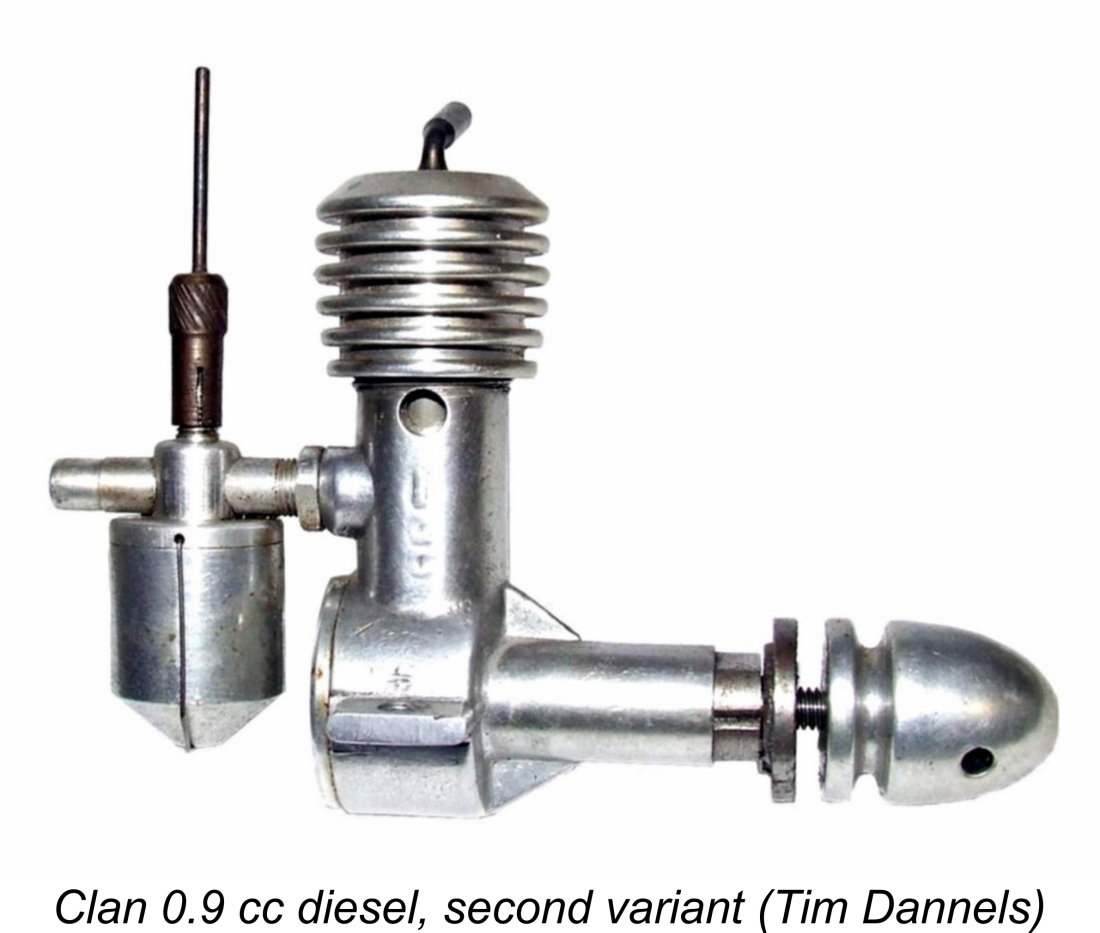 A few years ago, my late and much-missed mate Ron Chernich put up a brief article on his
A few years ago, my late and much-missed mate Ron Chernich put up a brief article on his 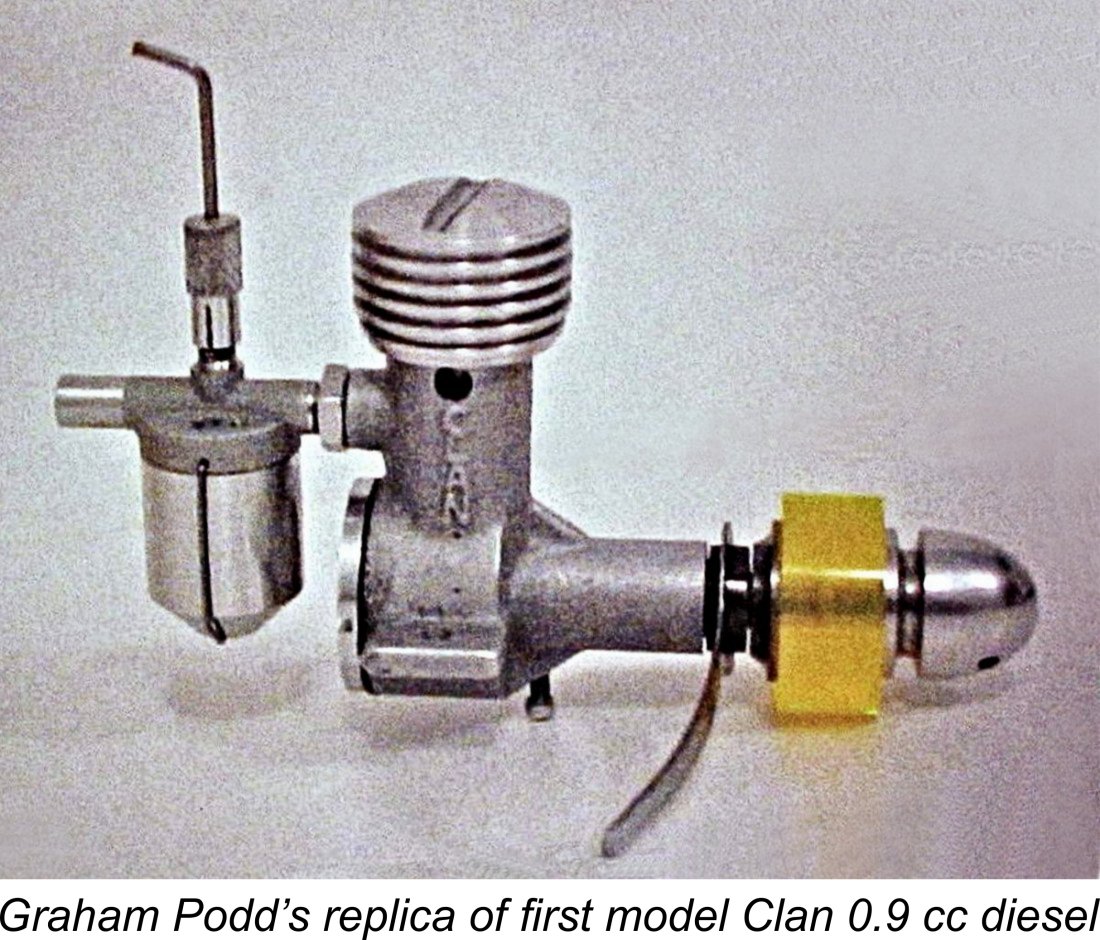 ation. Moreover, a number of key questions surrounding the Clan range in general were left unanswered. The present article is intended not to supplant Ron’s earlier work but rather to complement it by filling in some of the gaps in its coverage.
ation. Moreover, a number of key questions surrounding the Clan range in general were left unanswered. The present article is intended not to supplant Ron’s earlier work but rather to complement it by filling in some of the gaps in its coverage.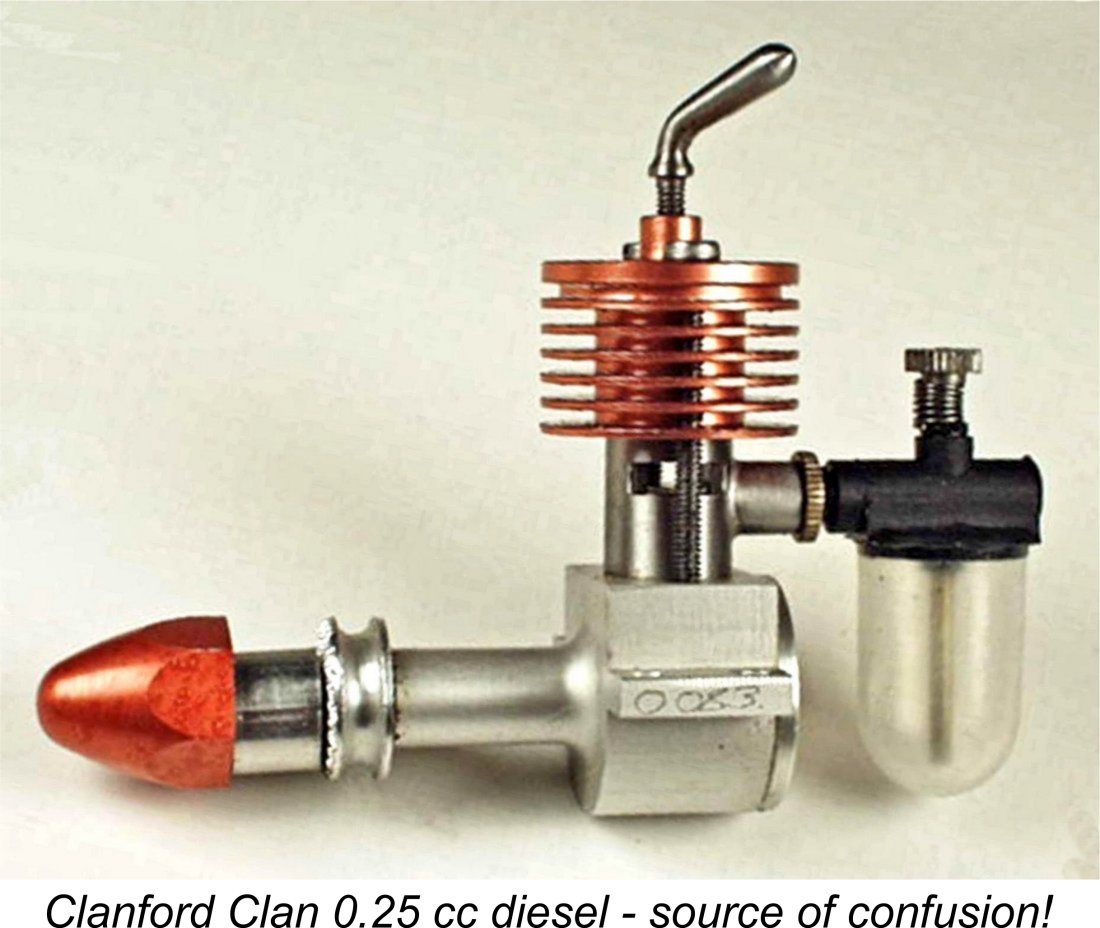 nes, it’s necessary to deal right away with a potential source of confusion. In 1991 Mike Clanford instigated the production of a batch of 0.24 cc sideport diesels which were marketed as the
nes, it’s necessary to deal right away with a potential source of confusion. In 1991 Mike Clanford instigated the production of a batch of 0.24 cc sideport diesels which were marketed as the 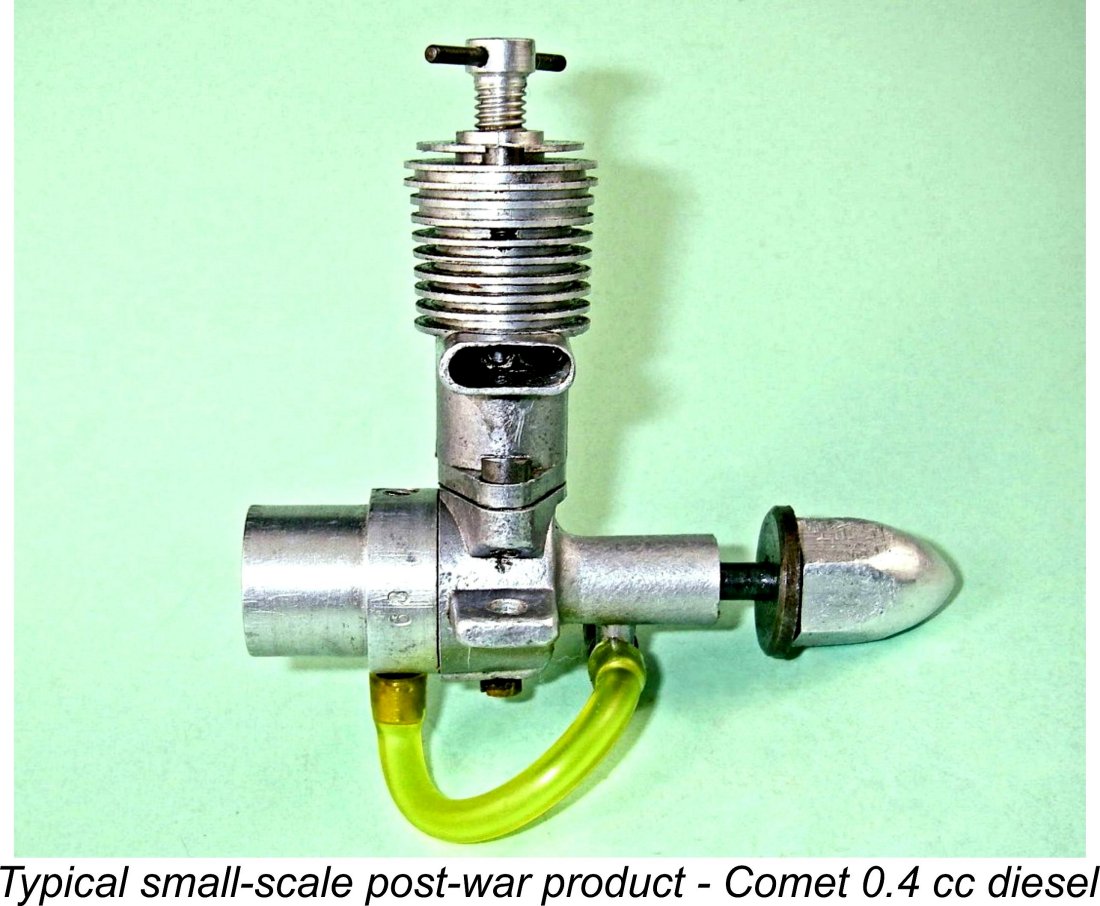 , so any motor that would start and run reasonably well most of the time was pretty much assured of a buyer.
, so any motor that would start and run reasonably well most of the time was pretty much assured of a buyer.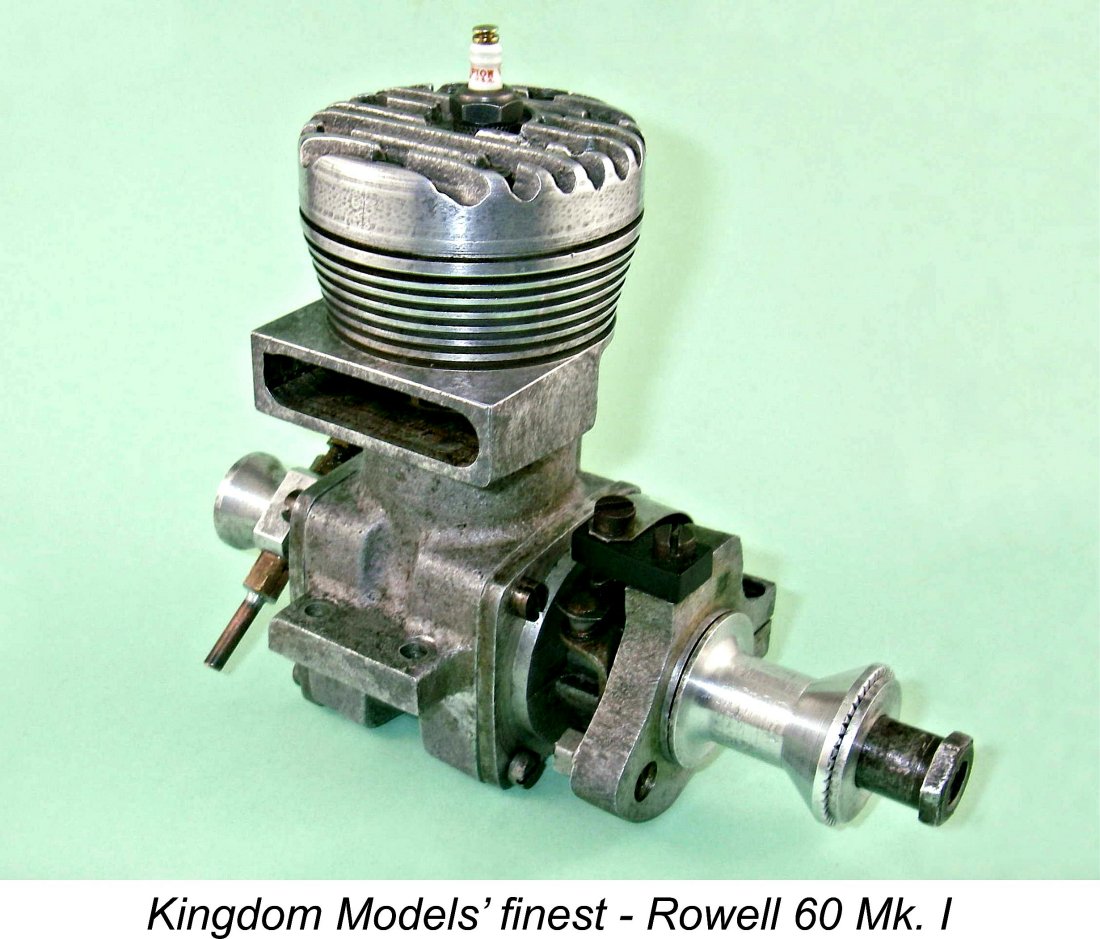

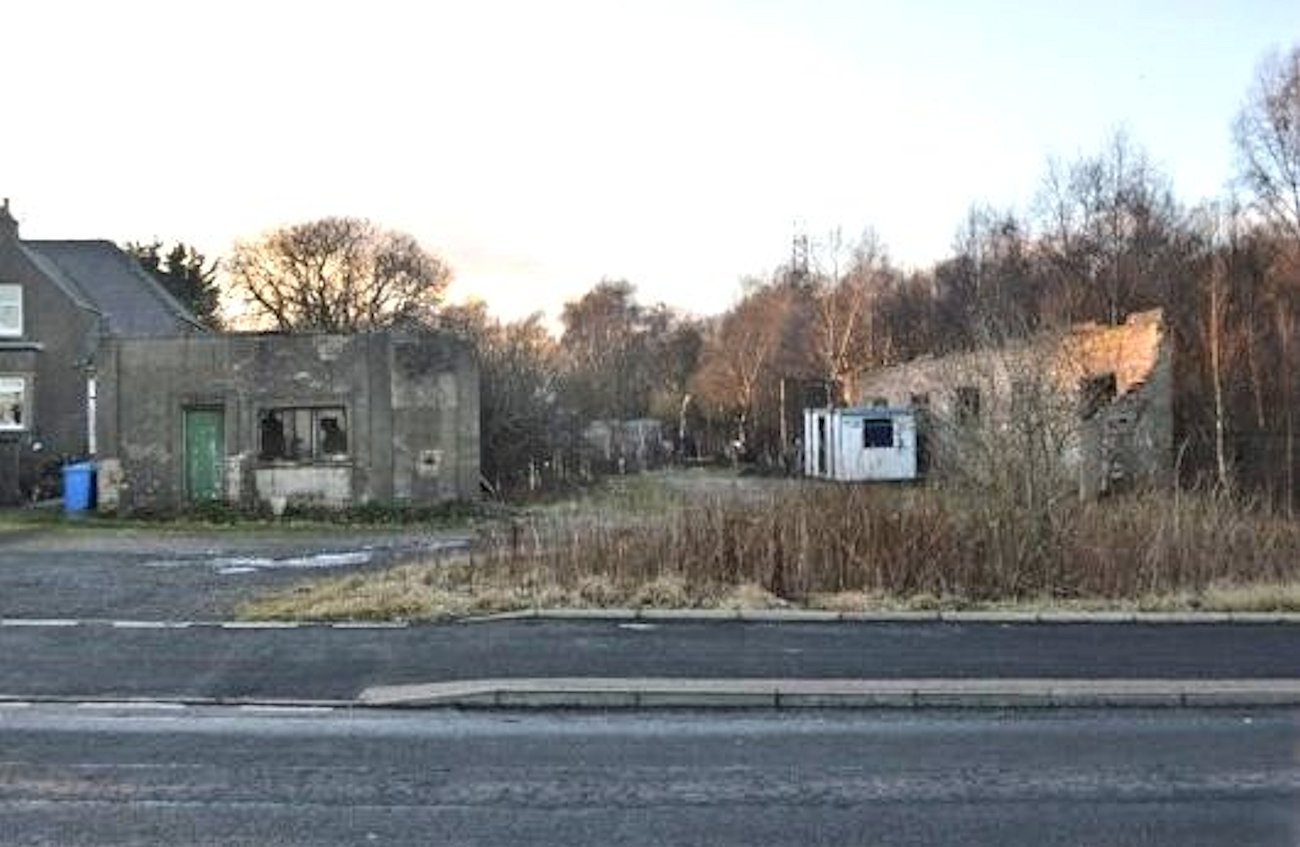 The identification of this derelict facility as a former model engine manufacturing location is supported by the recollections of one of Don Imrie's older club-mates, who did some electrical work there when it was still in operation. He recalled seeing a number of model engine components being handled. He wasn't able to positively identify these, but both Clan and Rowell components are distinct possibilities.
The identification of this derelict facility as a former model engine manufacturing location is supported by the recollections of one of Don Imrie's older club-mates, who did some electrical work there when it was still in operation. He recalled seeing a number of model engine components being handled. He wasn't able to positively identify these, but both Clan and Rowell components are distinct possibilities. 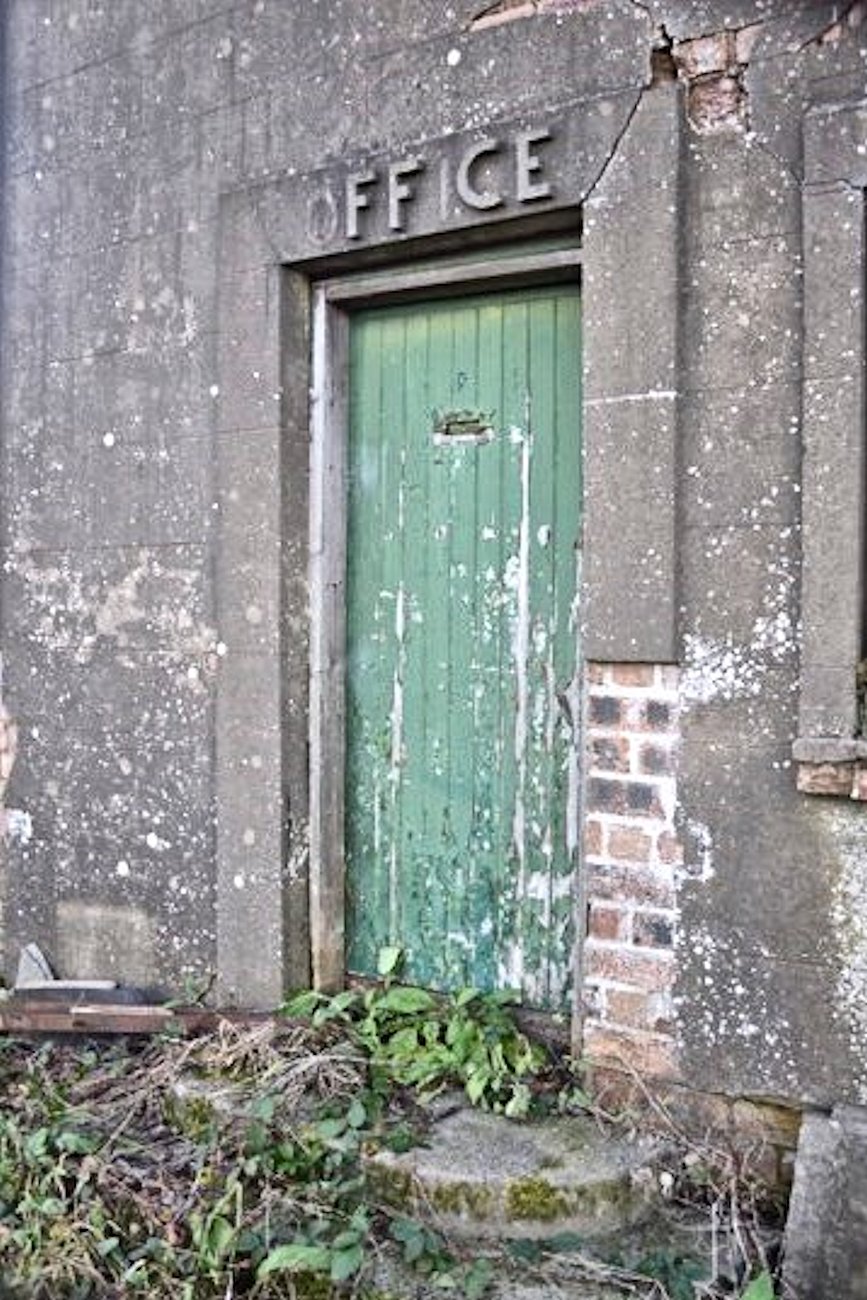 ther confirmation was obtained by Don Imrie through an interview with the occupant of the adjacent house seen in the photograph. He told Don that the factory was built in around 1935, a few years after the adjacent house. During WW2 it either built or repaired components for
ther confirmation was obtained by Don Imrie through an interview with the occupant of the adjacent house seen in the photograph. He told Don that the factory was built in around 1935, a few years after the adjacent house. During WW2 it either built or repaired components for 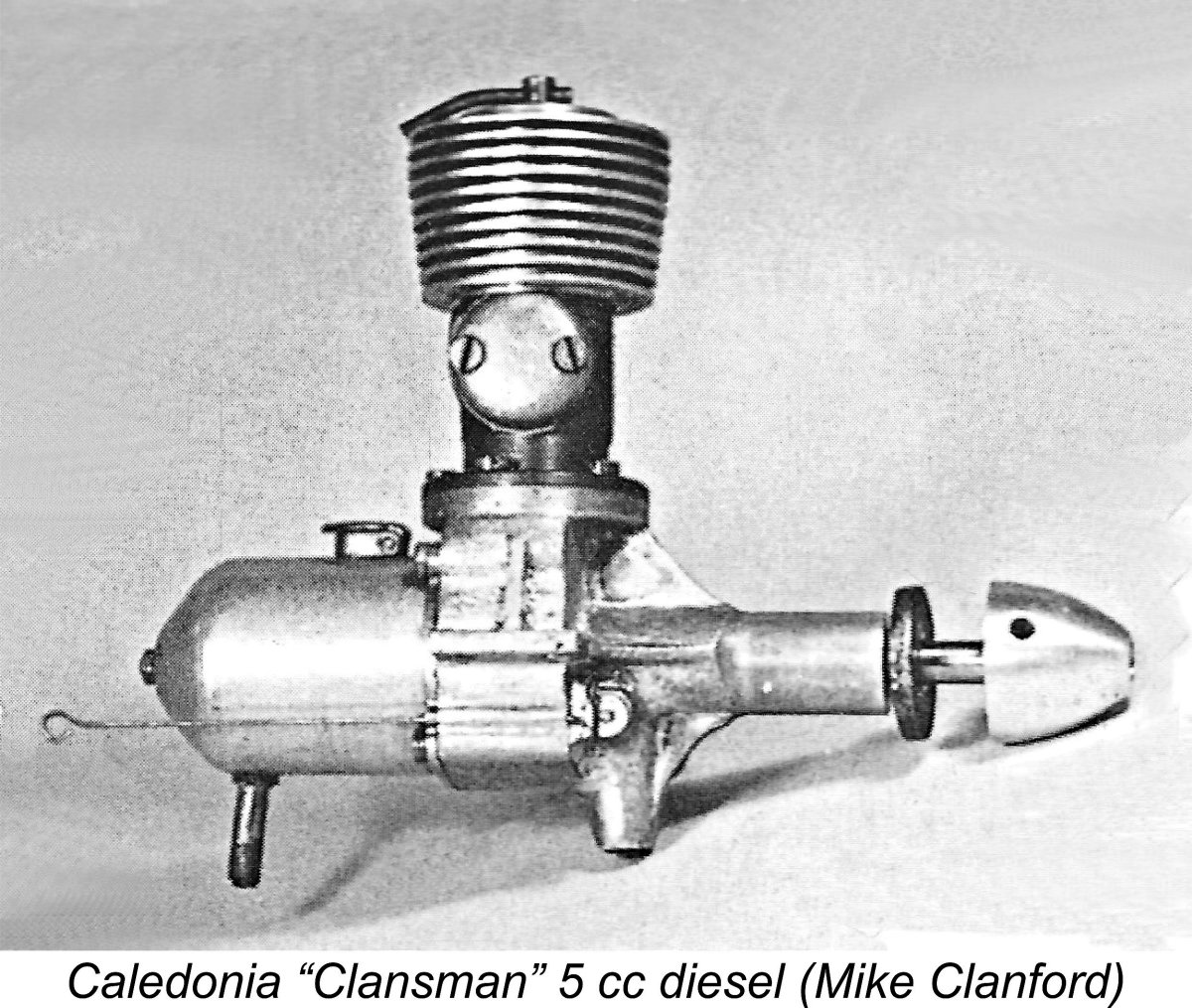 It has been widely assumed in the past that the manufacturers of the Clan 0.9 cc model (Kingdom Models) also made the 5 cc Clansman diesel and 5 cc Falcon spark ignition units promoted by the Caledonia Model Co. of 5 Pitt Street in Glasgow, Scotland beginning in June 1946. This is an assertion that merts close examination. Although it's a very logical assumption, I am not currently aware of any direct evidence to support this connection, which I personally consider to be unproven at this point in time. If any reader has such evidence, I'd be immensely grateful if it could be shared! I'll happily amend this section of the article, with full acknowledgement!
It has been widely assumed in the past that the manufacturers of the Clan 0.9 cc model (Kingdom Models) also made the 5 cc Clansman diesel and 5 cc Falcon spark ignition units promoted by the Caledonia Model Co. of 5 Pitt Street in Glasgow, Scotland beginning in June 1946. This is an assertion that merts close examination. Although it's a very logical assumption, I am not currently aware of any direct evidence to support this connection, which I personally consider to be unproven at this point in time. If any reader has such evidence, I'd be immensely grateful if it could be shared! I'll happily amend this section of the article, with full acknowledgement! 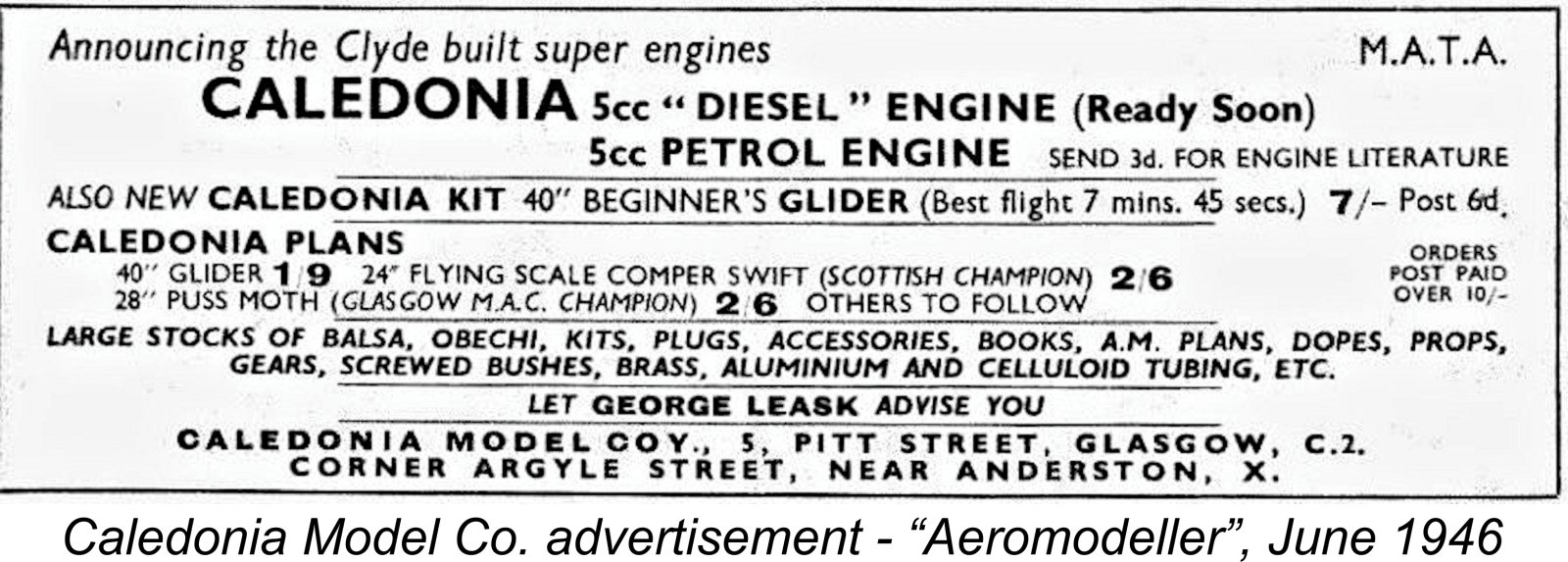
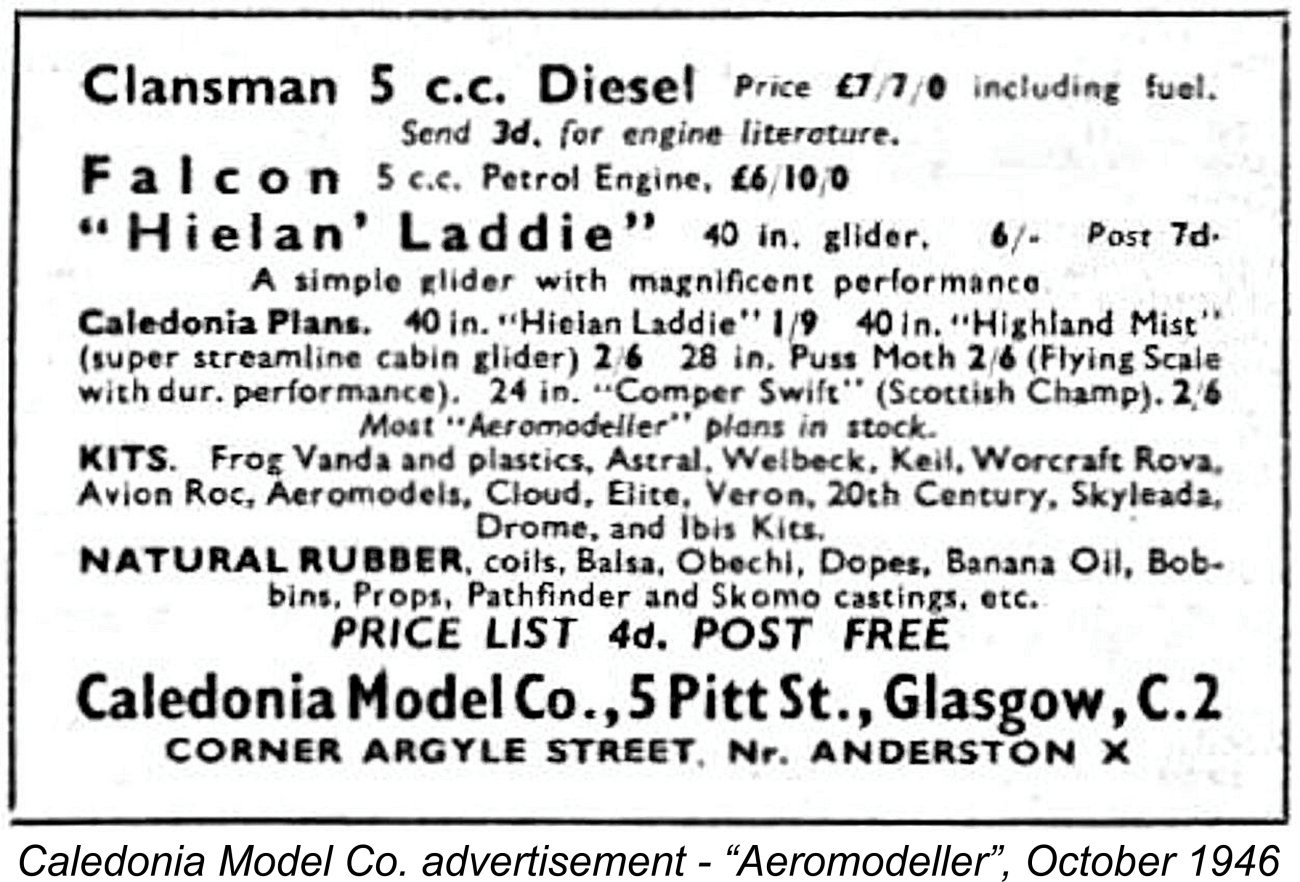 By October of 1946 both the Caledonia diesel and spark ignition models had made their appearance in the company's advertising. By this time they had acquired the model names of the Clansman 5 cc diesel and the Falcon 5 cc petrol engine. From the outset, they were promoted by the Caledonia Model Co. as their own "house" range. The terms "Clansman" and "Falcon" were specifically presented as the names of particular Caledonia models, as opposed to brand names.
By October of 1946 both the Caledonia diesel and spark ignition models had made their appearance in the company's advertising. By this time they had acquired the model names of the Clansman 5 cc diesel and the Falcon 5 cc petrol engine. From the outset, they were promoted by the Caledonia Model Co. as their own "house" range. The terms "Clansman" and "Falcon" were specifically presented as the names of particular Caledonia models, as opposed to brand names.  Moreover, the Astral Aero Model Co. advertising for the Clan 0.9 cc model (see below) specifically referred to the previously-cited entity named Clan Models as the originators of the Clan 0.9 cc diesel. So did Lawrence Sparey (writing as "Artifex", pseudonyms being a commonly-employed device among British technical writers at the time) in his “British Diesel Summary” which appeared in the May 1947 issue of “Aeromodeller” magazine.
Moreover, the Astral Aero Model Co. advertising for the Clan 0.9 cc model (see below) specifically referred to the previously-cited entity named Clan Models as the originators of the Clan 0.9 cc diesel. So did Lawrence Sparey (writing as "Artifex", pseudonyms being a commonly-employed device among British technical writers at the time) in his “British Diesel Summary” which appeared in the May 1947 issue of “Aeromodeller” magazine. 
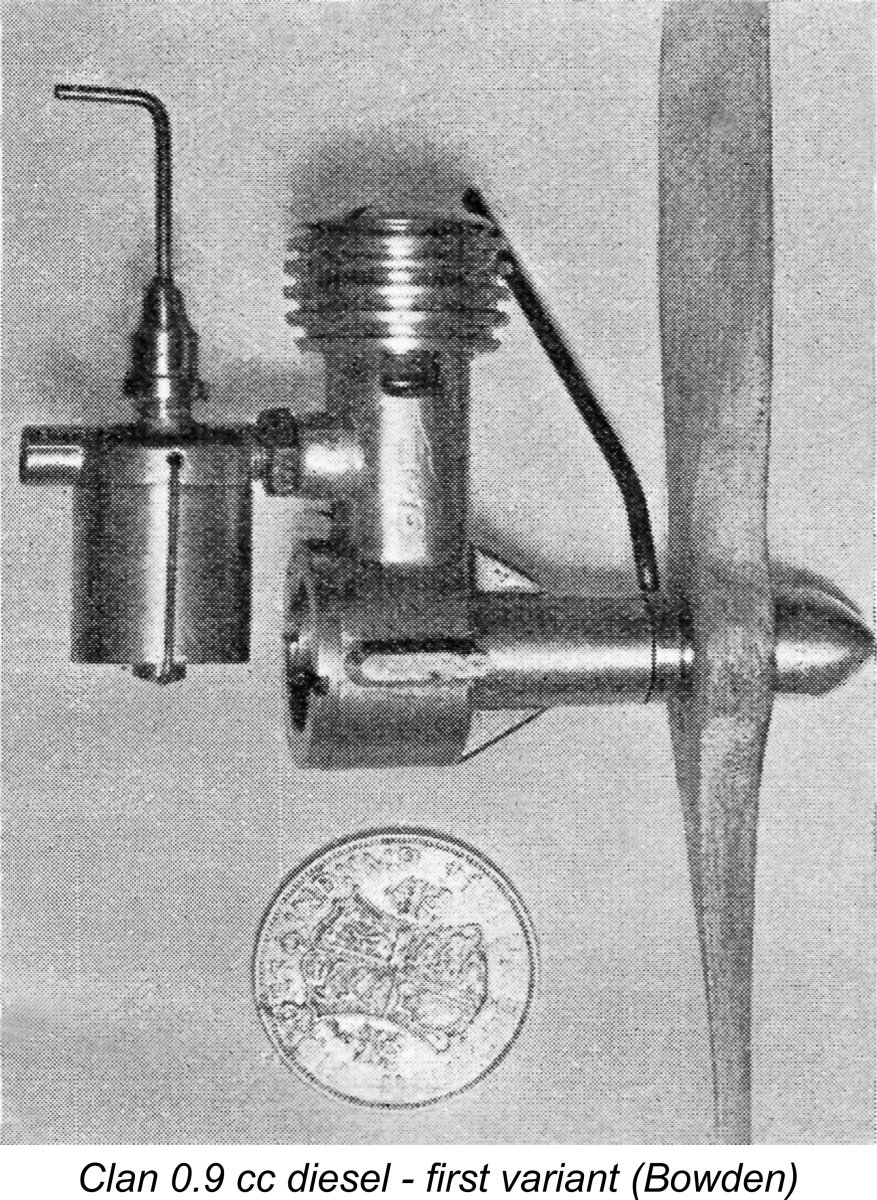 The Clan 0.9 cc diesel was a sideport unit which was successively produced in two quite distinct variants. The first and least common of these used the eccentric bearing form of compression adjustment. In this system, the main bearing bushing was bored off centre, and the bushing could be rotated in its housing through the use of a suitable lever attached at the front. This had the effect of varying the vertical location of the shaft and hence the distance between the fixed cylinder head and the piston crown at top dead centre. This in turn altered the operating compression ratio.
The Clan 0.9 cc diesel was a sideport unit which was successively produced in two quite distinct variants. The first and least common of these used the eccentric bearing form of compression adjustment. In this system, the main bearing bushing was bored off centre, and the bushing could be rotated in its housing through the use of a suitable lever attached at the front. This had the effect of varying the vertical location of the shaft and hence the distance between the fixed cylinder head and the piston crown at top dead centre. This in turn altered the operating compression ratio.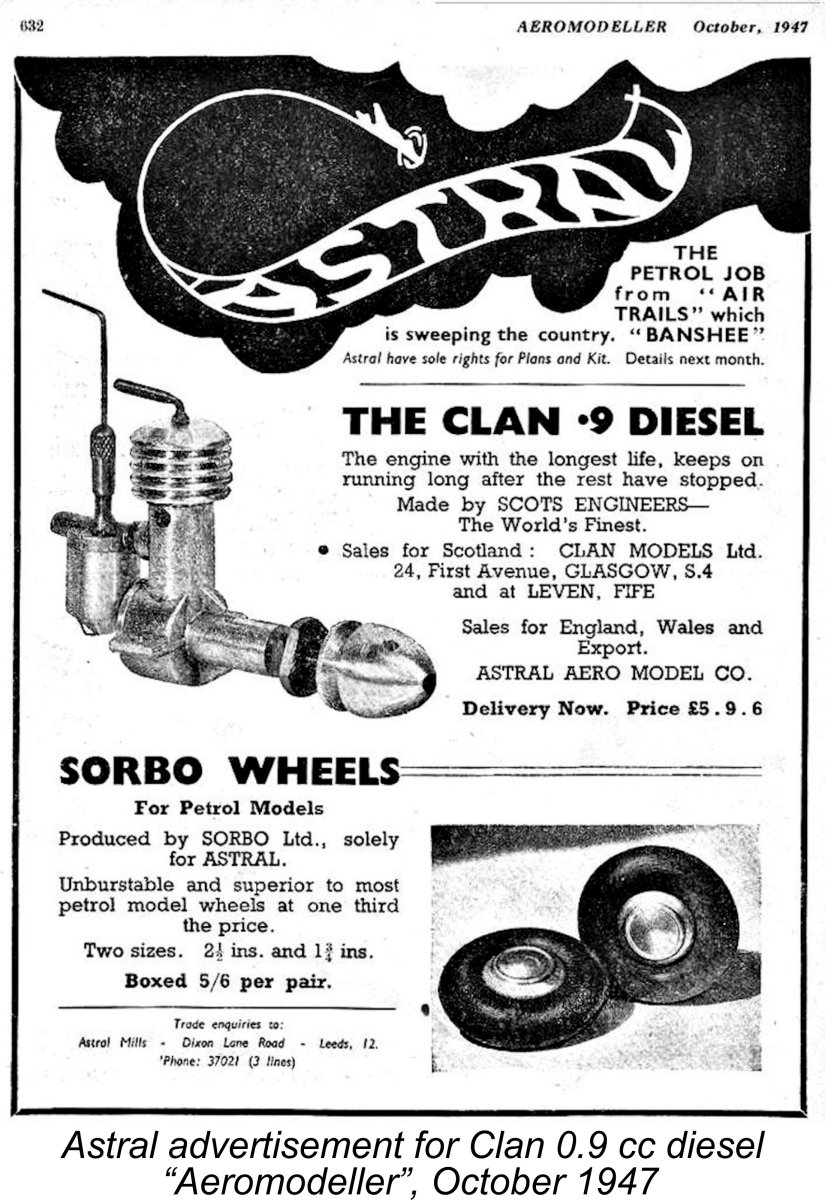 bushing compression adjustment system with the far simpler contra piston and comp screw set-up which was then rapidly becoming the accepted design standard for model diesels.
bushing compression adjustment system with the far simpler contra piston and comp screw set-up which was then rapidly becoming the accepted design standard for model diesels.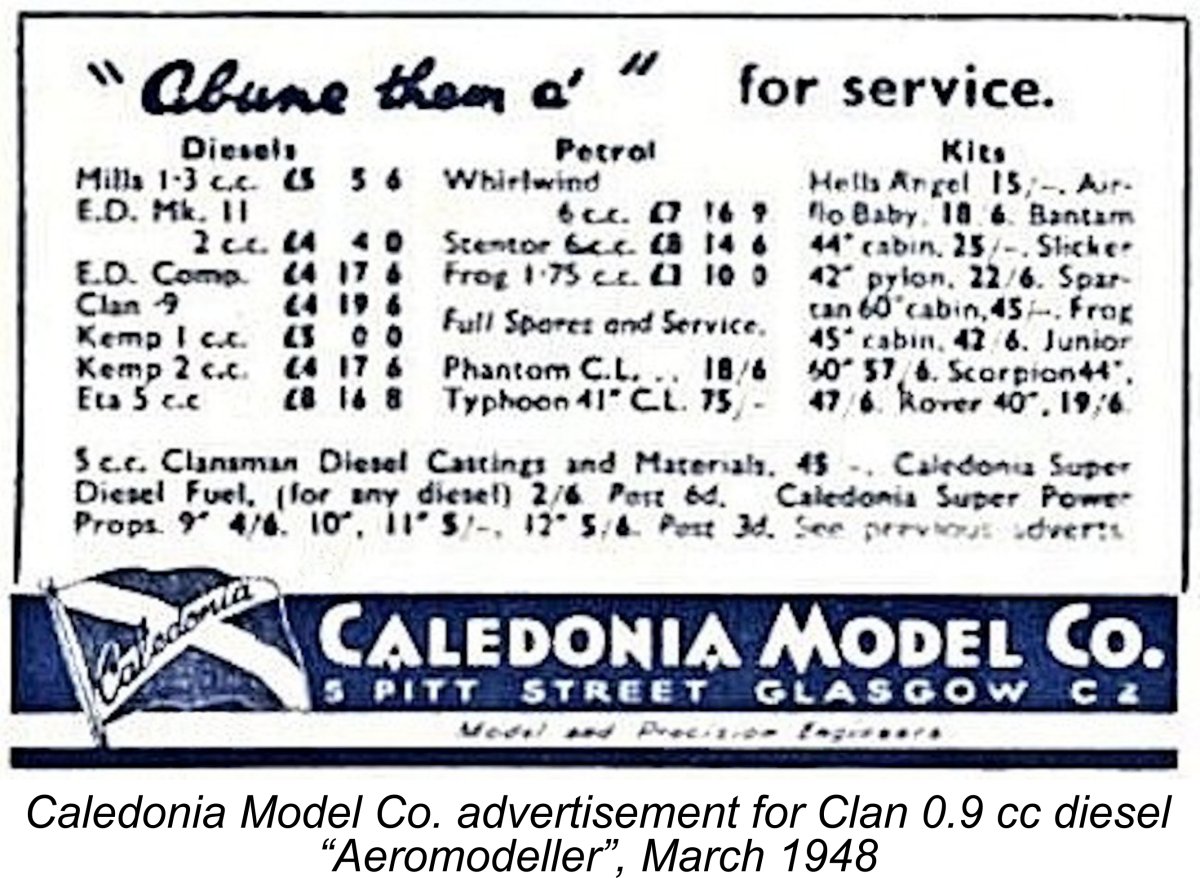
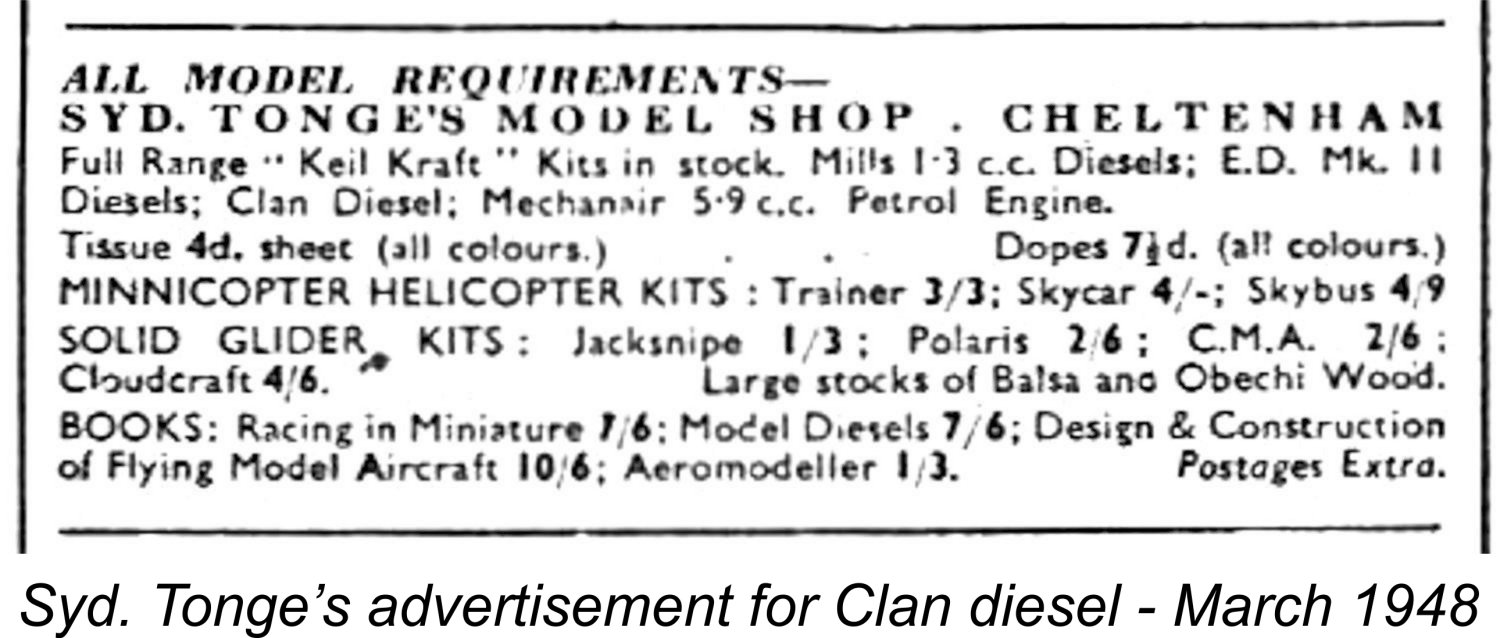
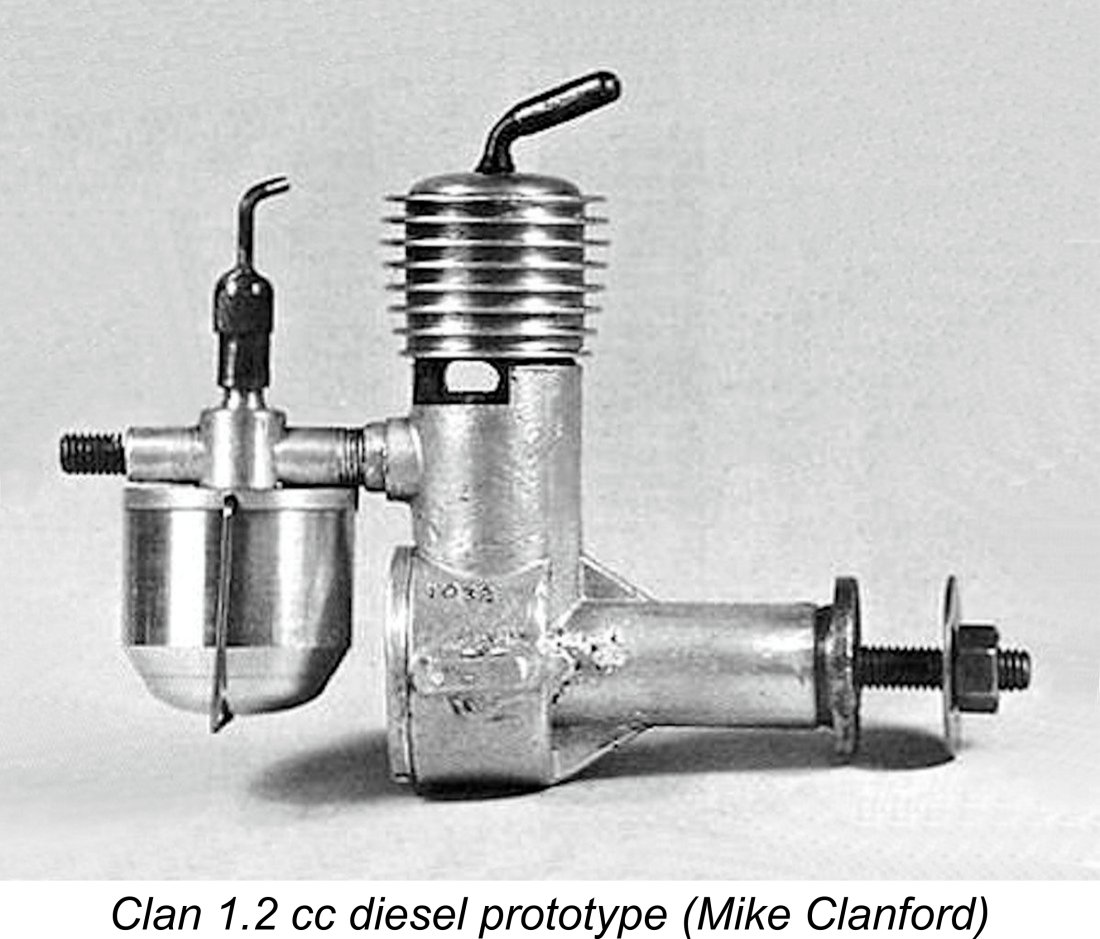
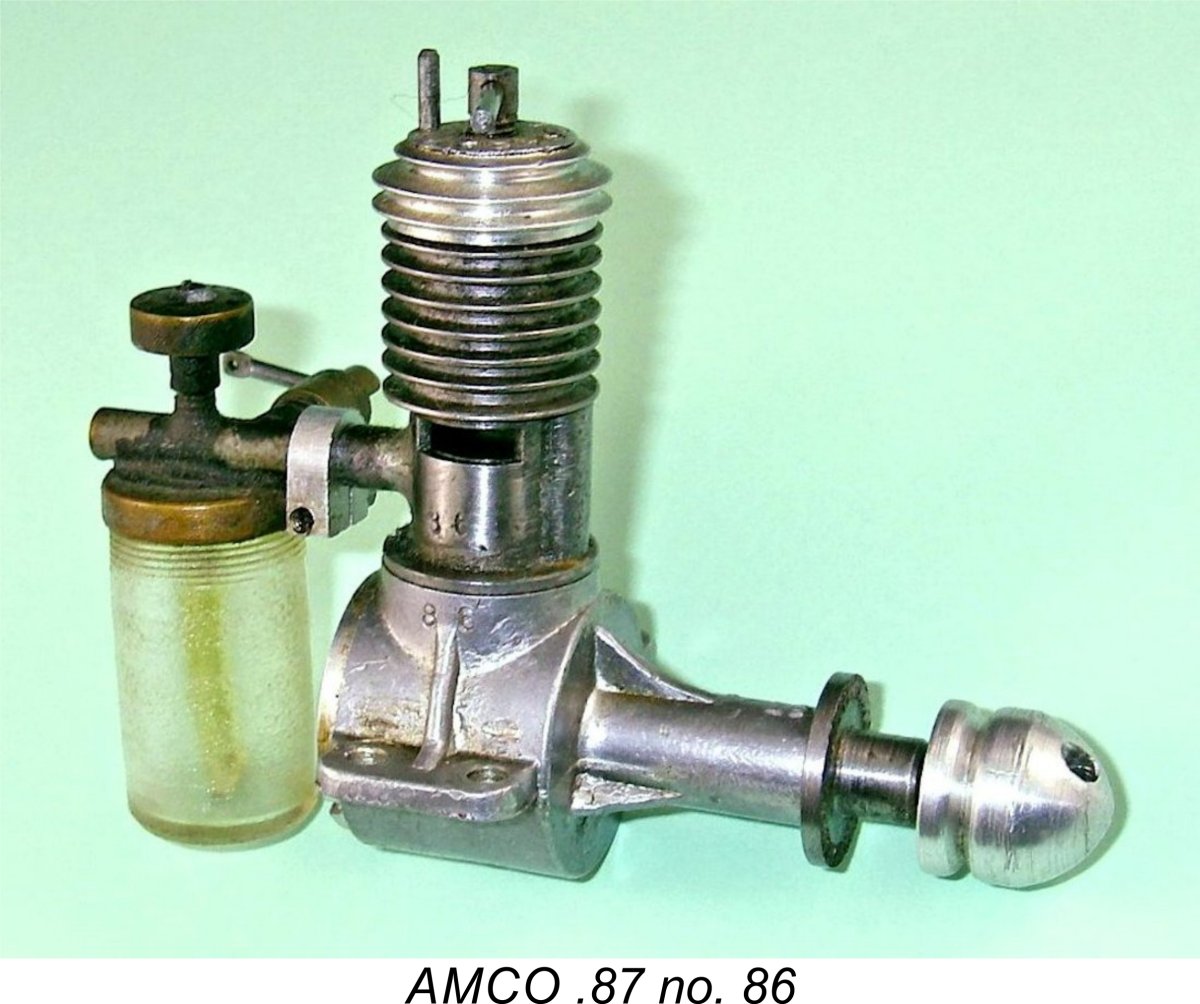
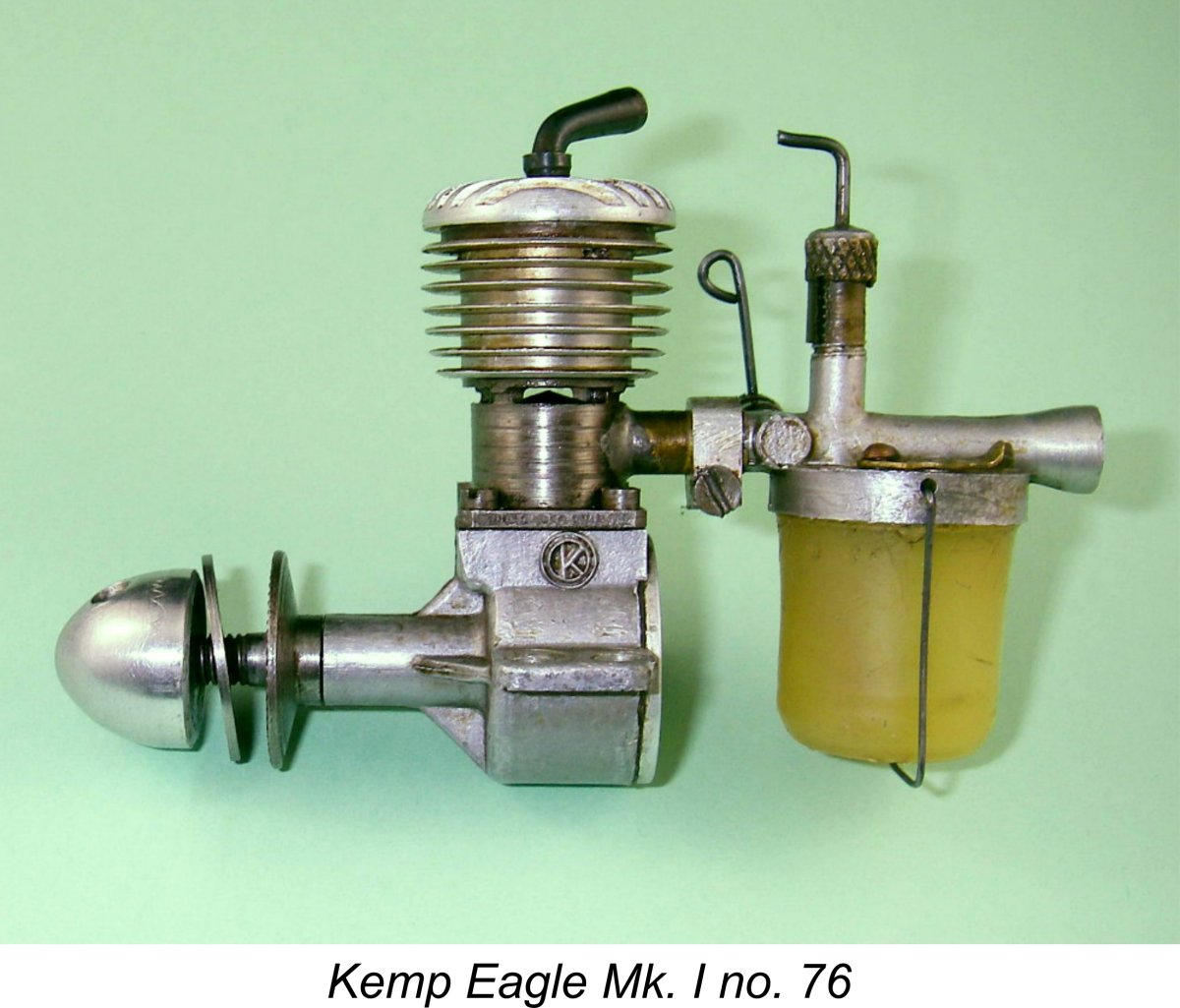
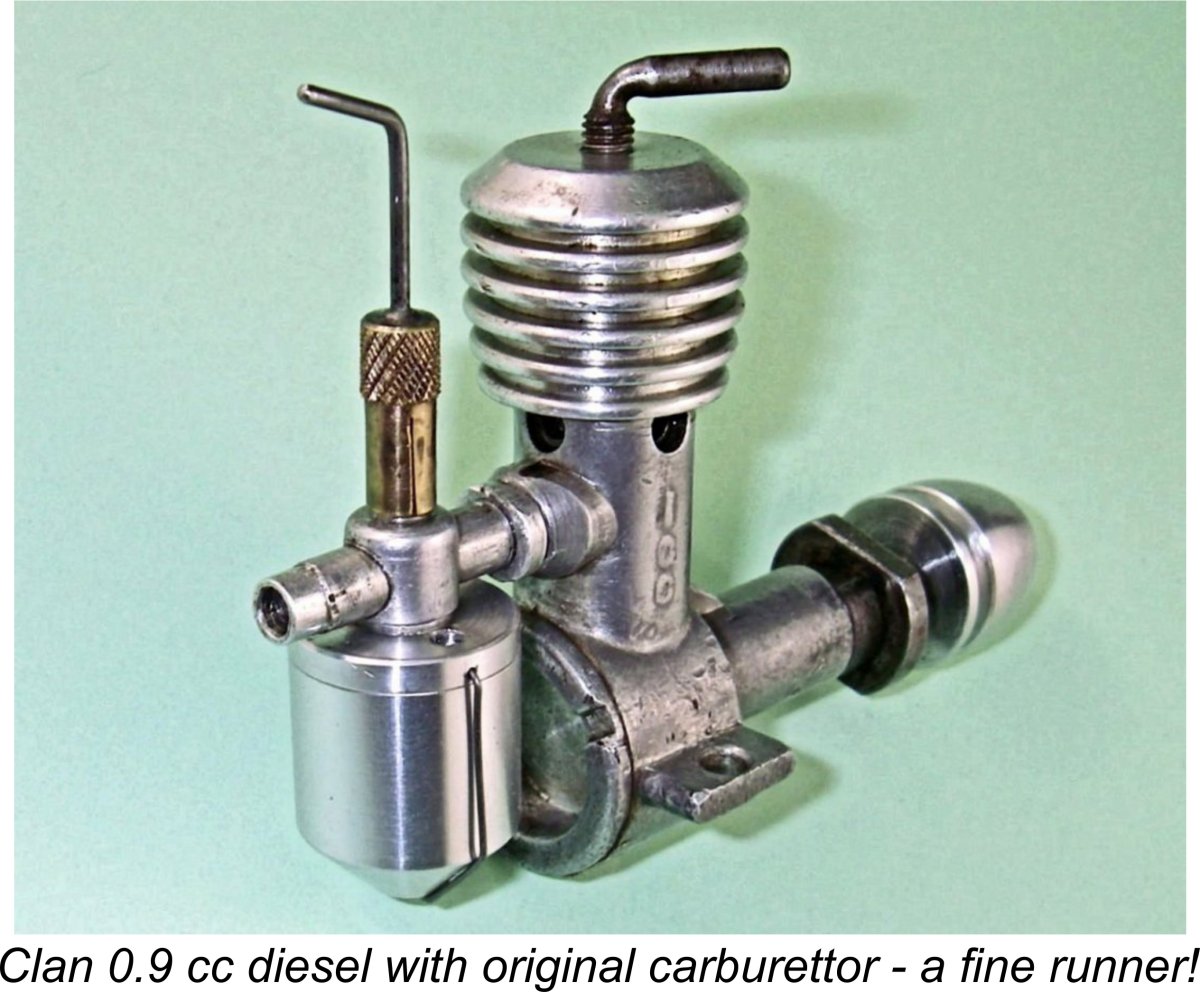 However, that's not the end of it - things become even more problematic! Arthur went on to state that as supplied by the manufacturer, the Clan 0.9 cc diesel "wasn't worth a light .........wouldn't start, wouldn't run. Then we discovered that if we fitted a Mills 1.3 carb they started and ran well. So that's what we did with every one that we sold - took off the Clan carb and substituted a Mills".
However, that's not the end of it - things become even more problematic! Arthur went on to state that as supplied by the manufacturer, the Clan 0.9 cc diesel "wasn't worth a light .........wouldn't start, wouldn't run. Then we discovered that if we fitted a Mills 1.3 carb they started and ran well. So that's what we did with every one that we sold - took off the Clan carb and substituted a Mills". 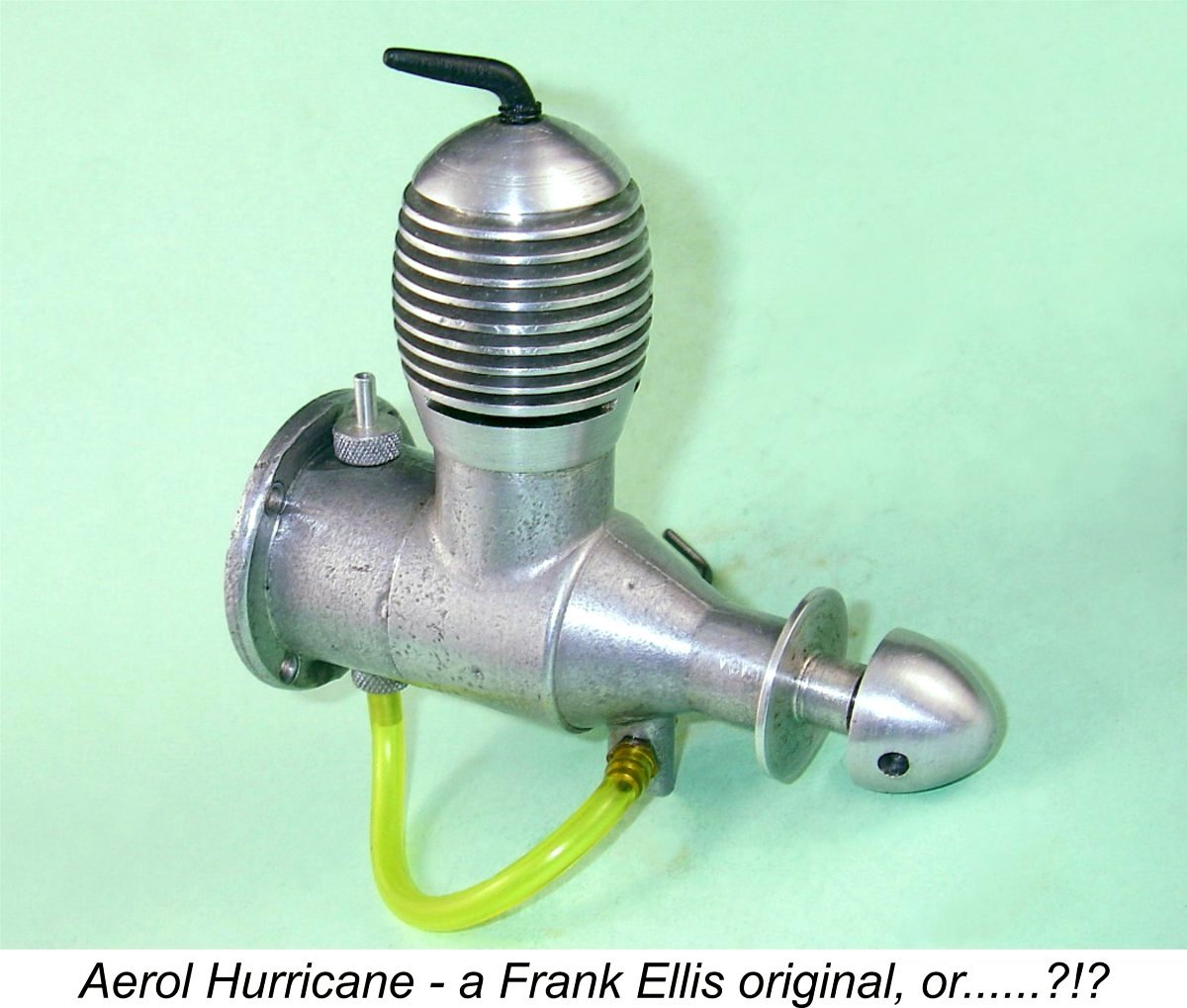
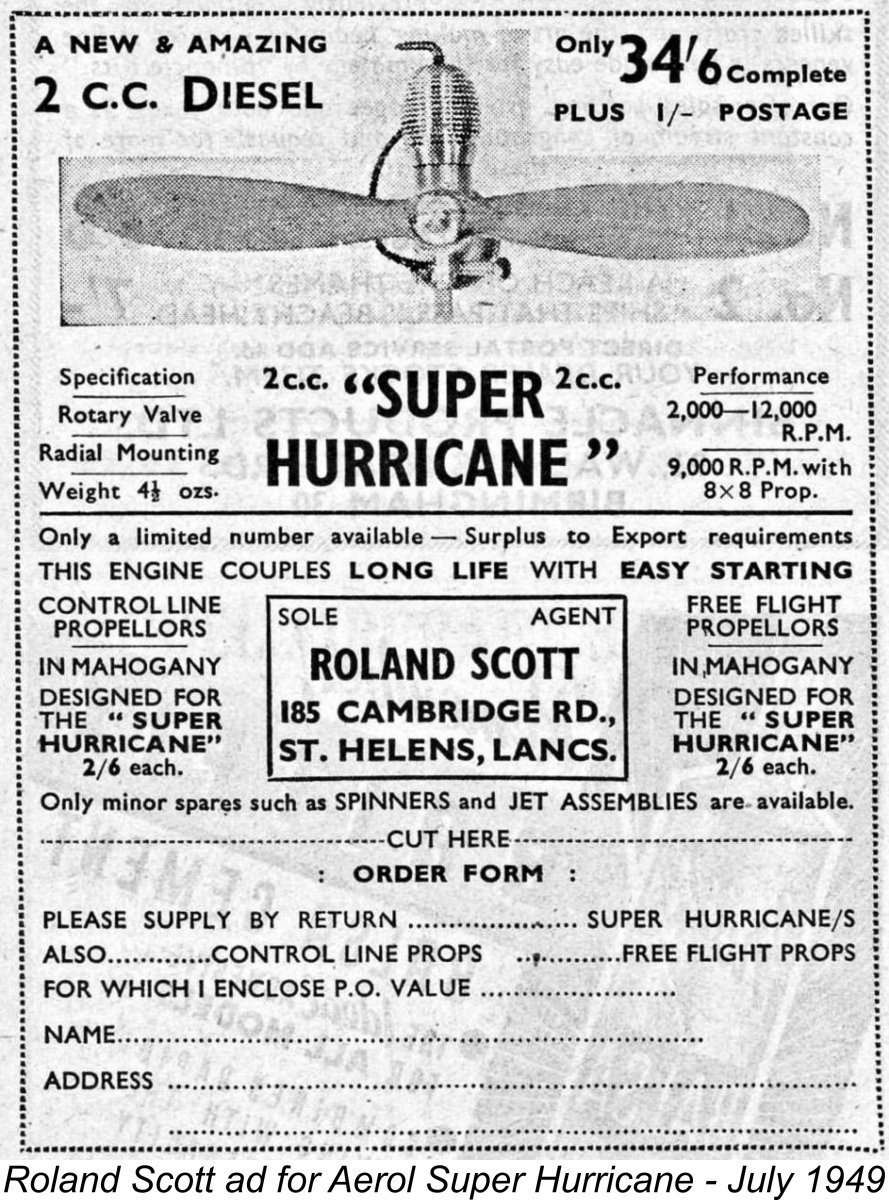 Such a close Scott/Ellis connection would undoubtedly explain the incontrovertible fact that Roland Scott's very first national advertisement ("Aeromodeller", July 1949) specifically referred to the availability at a very competitive price of examples of the "Super Hurricane" 2 cc diesel which were "surplus to export requirements". A glance at the image associated with this advertisement confirms that the engine to which it refers is unquestionably the Aerol Hurricane 2 cc diesel which has been fully documented
Such a close Scott/Ellis connection would undoubtedly explain the incontrovertible fact that Roland Scott's very first national advertisement ("Aeromodeller", July 1949) specifically referred to the availability at a very competitive price of examples of the "Super Hurricane" 2 cc diesel which were "surplus to export requirements". A glance at the image associated with this advertisement confirms that the engine to which it refers is unquestionably the Aerol Hurricane 2 cc diesel which has been fully documented 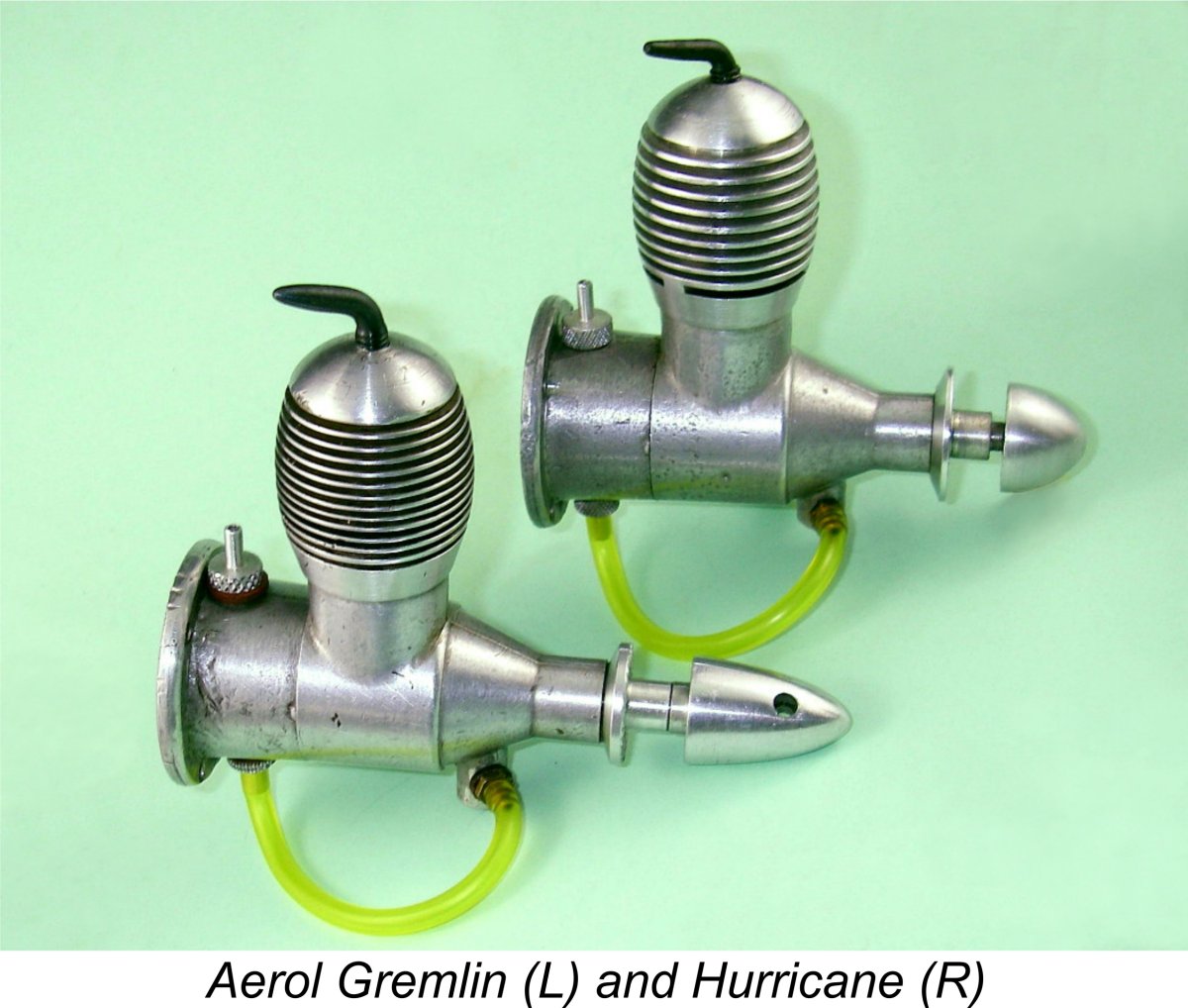 However, Frank did not mention the Clan engines at any point in his lengthy "tell all" interview with Jim Woodside. If there had been a connection, it seems inconceivable to me that Frank would not have recalled it - the level of detail which he did recall about the early years at Aerol Enginering was truly impressive. No hearsay here - I have the recording.
However, Frank did not mention the Clan engines at any point in his lengthy "tell all" interview with Jim Woodside. If there had been a connection, it seems inconceivable to me that Frank would not have recalled it - the level of detail which he did recall about the early years at Aerol Enginering was truly impressive. No hearsay here - I have the recording.  The second variant of the Clan 0.9 cc diesel was basically a fairly conventional sideport diesel of its time and place. This variant of the engine was included in Appendix II (Design and Constructional Data) of Ron Warring’s early 1949 book “
The second variant of the Clan 0.9 cc diesel was basically a fairly conventional sideport diesel of its time and place. This variant of the engine was included in Appendix II (Design and Constructional Data) of Ron Warring’s early 1949 book “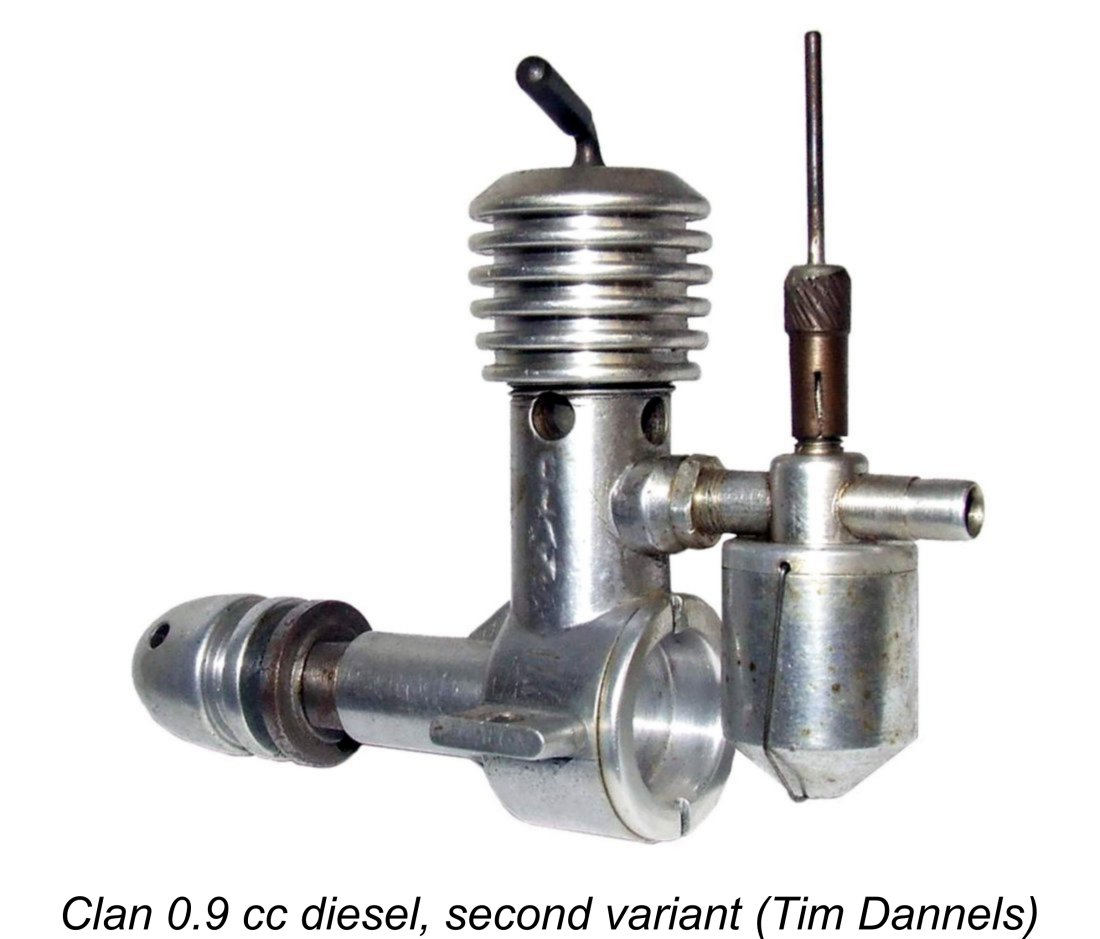 ployed. This was inserted into the externally threaded upper section of the gravity die-cast crankcase unit and secured by a screw-on aluminium alloy cooling jacket. The fit of the cylinder in the upper crankcase was very close indeed, effectively a light push fit in fact. This had the dual benefits of promoting better heat transfer between the cylinder and cooling jacket and also ensuring a gas-tight seal at the interface between the lower cylinder and the crankcase.
ployed. This was inserted into the externally threaded upper section of the gravity die-cast crankcase unit and secured by a screw-on aluminium alloy cooling jacket. The fit of the cylinder in the upper crankcase was very close indeed, effectively a light push fit in fact. This had the dual benefits of promoting better heat transfer between the cylinder and cooling jacket and also ensuring a gas-tight seal at the interface between the lower cylinder and the crankcase.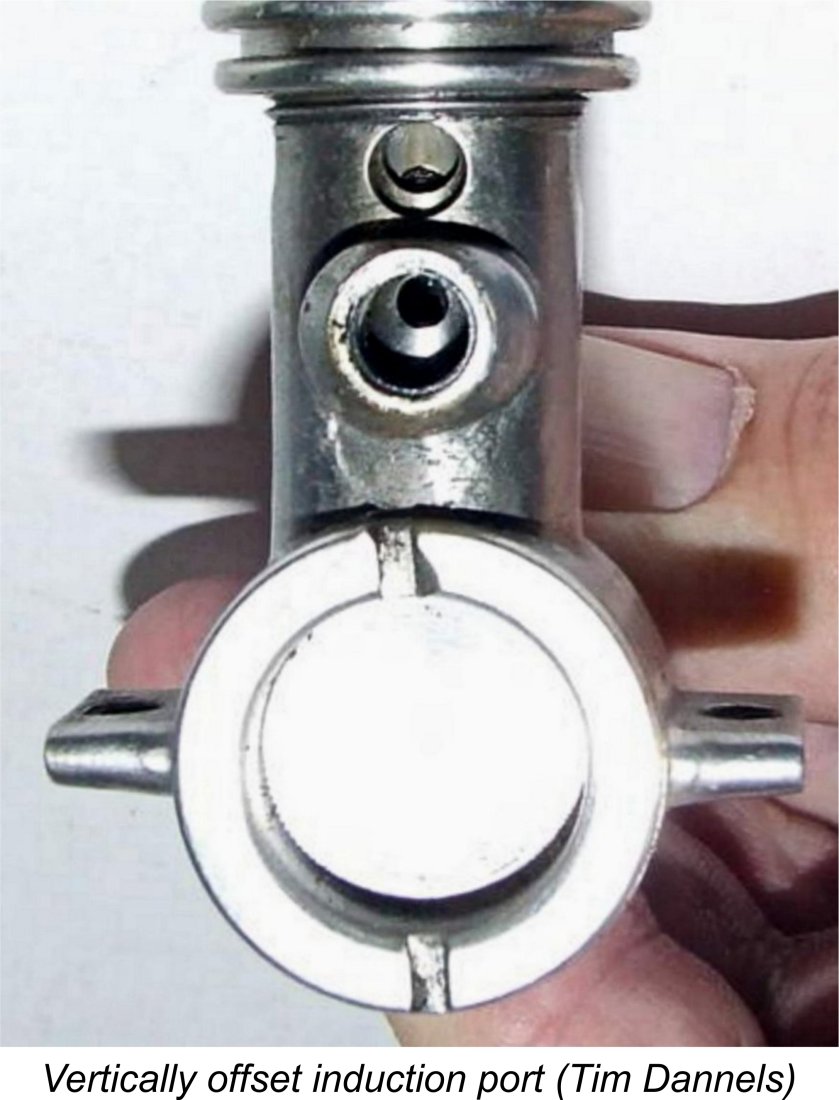 It’s interesting to note that the presence of the rear exhaust opening forced the designer to locate the internally-threaded spigot for the intake some distance below the axial centre-line of the cylinder induction port. It would appear that on these old slow-revving sideport designs, a “dog-leg” induction gas pathway simply didn’t matter much – look at the arrangement on the
It’s interesting to note that the presence of the rear exhaust opening forced the designer to locate the internally-threaded spigot for the intake some distance below the axial centre-line of the cylinder induction port. It would appear that on these old slow-revving sideport designs, a “dog-leg” induction gas pathway simply didn’t matter much – look at the arrangement on the 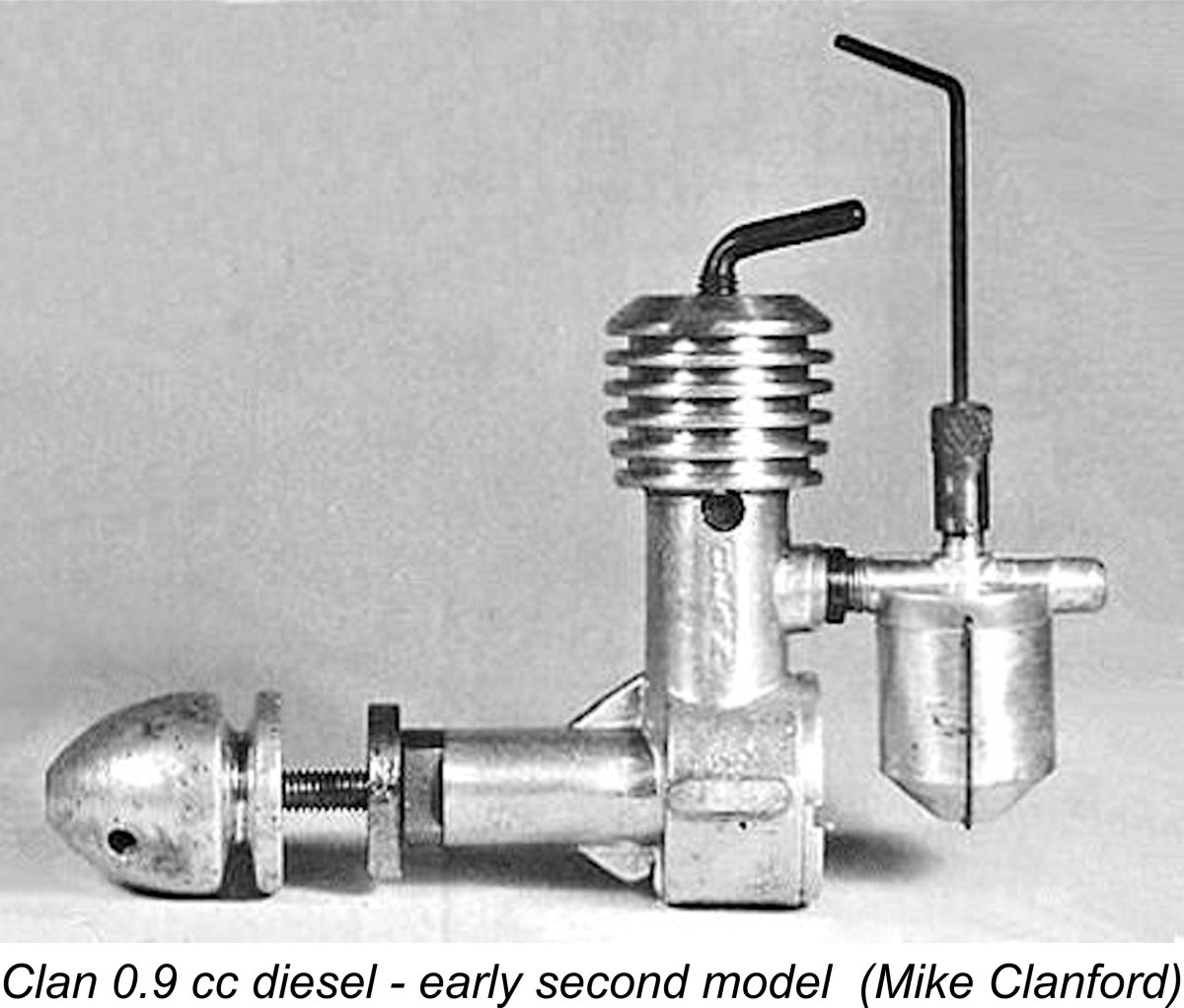 The earlier examples of the second model Clan 0.9 cc diesel used the tank from the first variant, which had a tank top cast in unit with the venturi. The example featured in the Astral advertisements was of this type, as was the example illustrated by Mike Clanford in his previously-cited A-Z book as reproduced at the right.
The earlier examples of the second model Clan 0.9 cc diesel used the tank from the first variant, which had a tank top cast in unit with the venturi. The example featured in the Astral advertisements was of this type, as was the example illustrated by Mike Clanford in his previously-cited A-Z book as reproduced at the right. 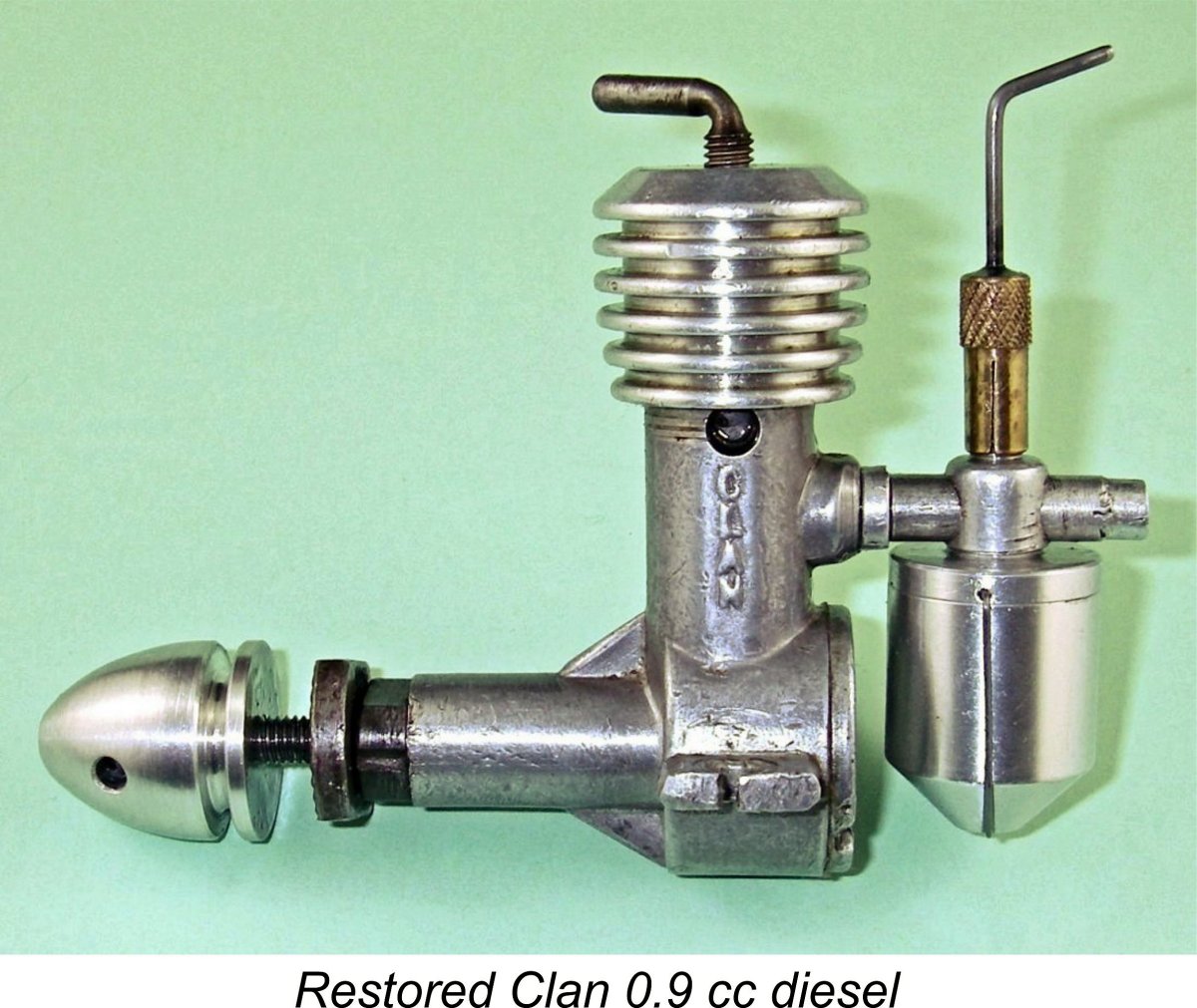 The example of the Clan 0.9 cc diesel which I was fortunate enough to acquire was by no means a perfect specimen! This is why I have chosen to feature Tim Dannels' excellent images of his as-new all-original example from Ron Chernich's earlier article. Ron gave me written permission to do so whenever the need arose.
The example of the Clan 0.9 cc diesel which I was fortunate enough to acquire was by no means a perfect specimen! This is why I have chosen to feature Tim Dannels' excellent images of his as-new all-original example from Ron Chernich's earlier article. Ron gave me written permission to do so whenever the need arose. 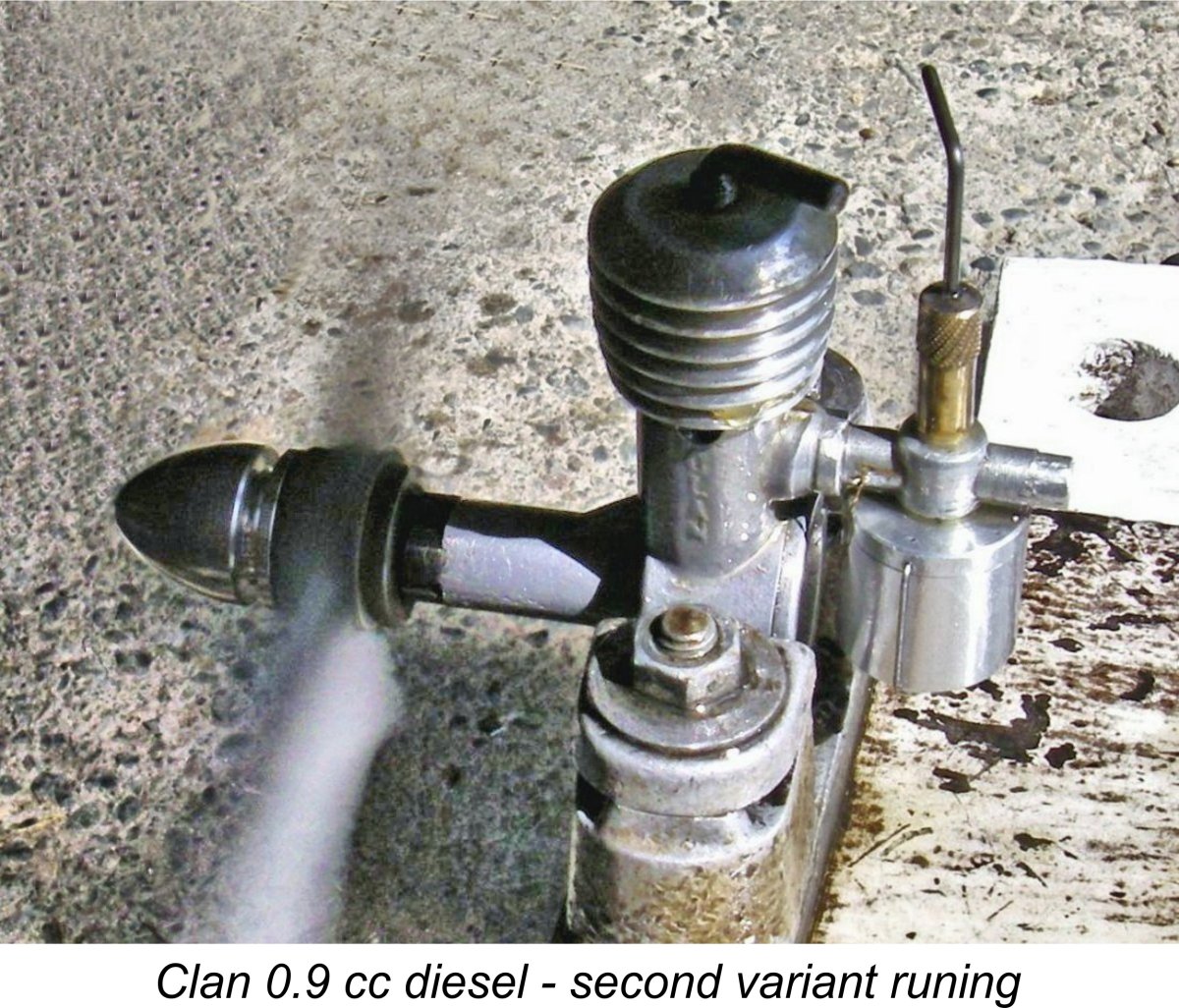 It immediately transpired that my reservations were completely groundless - the Mills carb could be returned to its original home! With a 9x4 APC prop fitted (the size recommended by Ron Warring), the little Clan started up right away and proceeded to run the tank out very smoothly! The only indication that suction might be a little less than optimal was the fact that the mixture showed signs of leaning out progressively as the relatively tall tank ran down, doubtless due to the considerable change in fuel head in the tank. However, if one made allowance for this by setting for the fully leaned-out condition near the end of the run, the motor would have delivered an excellent in-flight performance.
It immediately transpired that my reservations were completely groundless - the Mills carb could be returned to its original home! With a 9x4 APC prop fitted (the size recommended by Ron Warring), the little Clan started up right away and proceeded to run the tank out very smoothly! The only indication that suction might be a little less than optimal was the fact that the mixture showed signs of leaning out progressively as the relatively tall tank ran down, doubtless due to the considerable change in fuel head in the tank. However, if one made allowance for this by setting for the fully leaned-out condition near the end of the run, the motor would have delivered an excellent in-flight performance.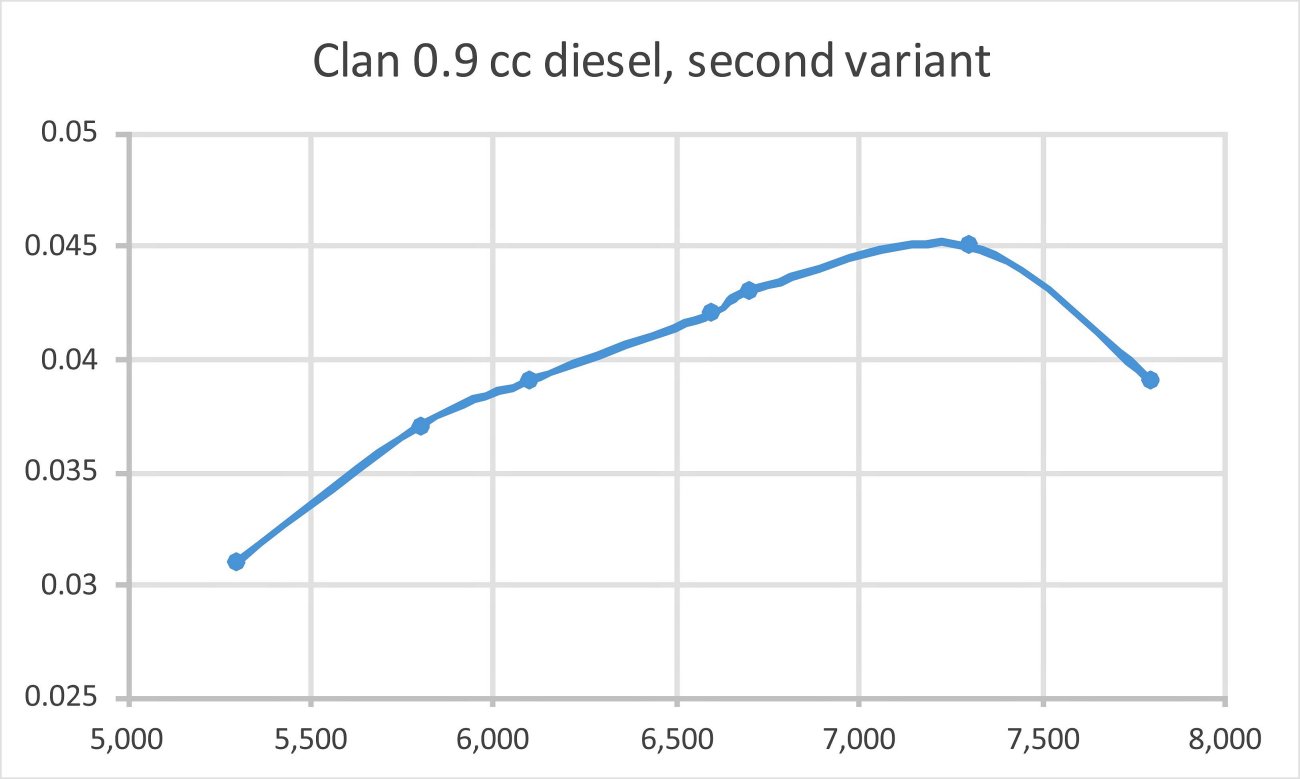
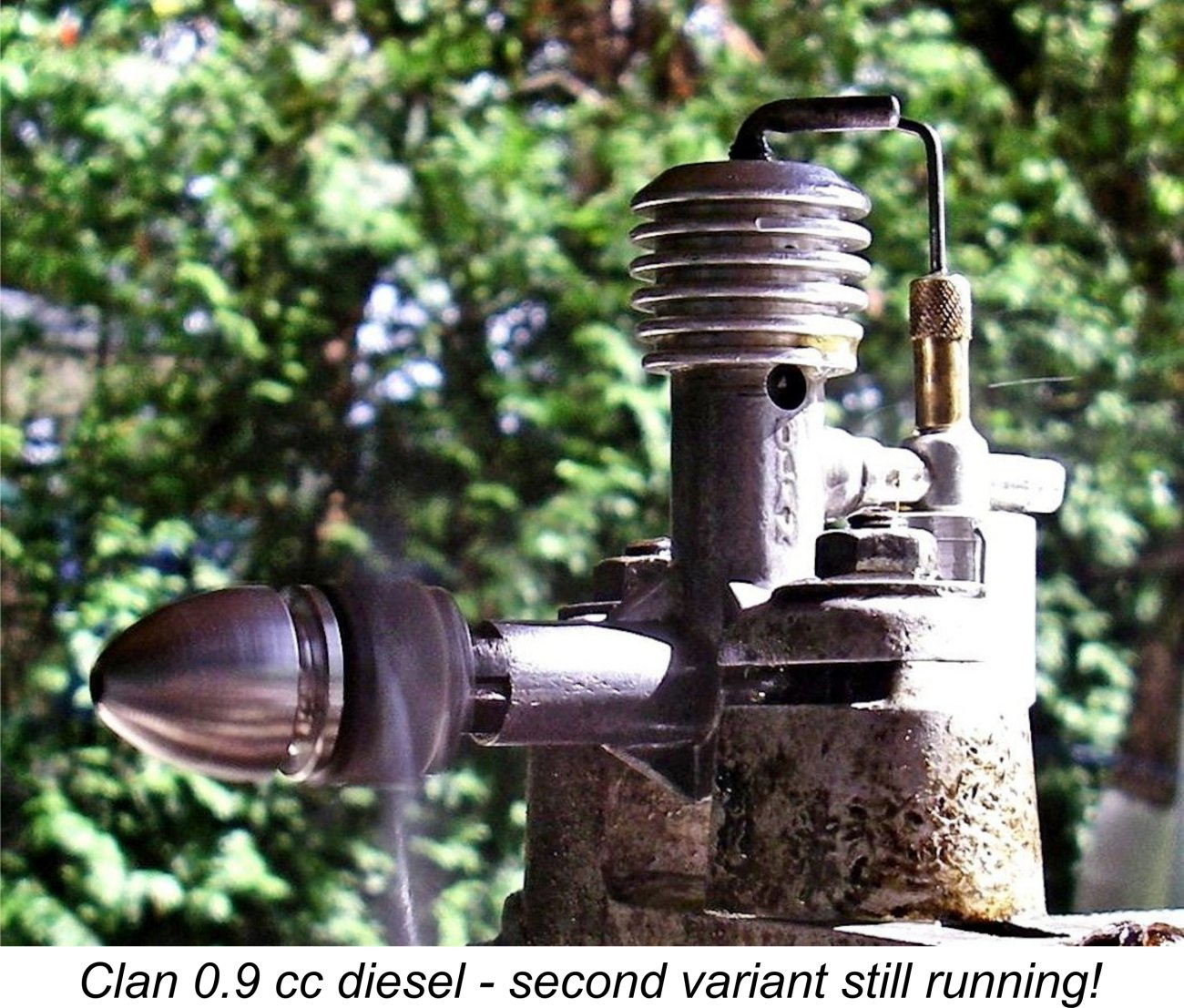 The results reported above imply an output of around 0.046 BHP @ 7,200 rpm or thereabouts. This may not sound like much, but context is everything in these matters. In a mid 1947 context, this is actually not a bad figure at all for an engine of this type and displacement! It's not far off the figures obtained during my recent test of an early (September 1948) E.D. Bee Mk. I Series I, which delivered some 0.047 BHP @ 8,000 rpm from its 10% larger displacement. The Clan develops essentially the same power but at a considerably lower speed, indicating an ability to turn a larger prop to very good effect. It must also be recalled that the Clan predates the Bee by a full year .......
The results reported above imply an output of around 0.046 BHP @ 7,200 rpm or thereabouts. This may not sound like much, but context is everything in these matters. In a mid 1947 context, this is actually not a bad figure at all for an engine of this type and displacement! It's not far off the figures obtained during my recent test of an early (September 1948) E.D. Bee Mk. I Series I, which delivered some 0.047 BHP @ 8,000 rpm from its 10% larger displacement. The Clan develops essentially the same power but at a considerably lower speed, indicating an ability to turn a larger prop to very good effect. It must also be recalled that the Clan predates the Bee by a full year .......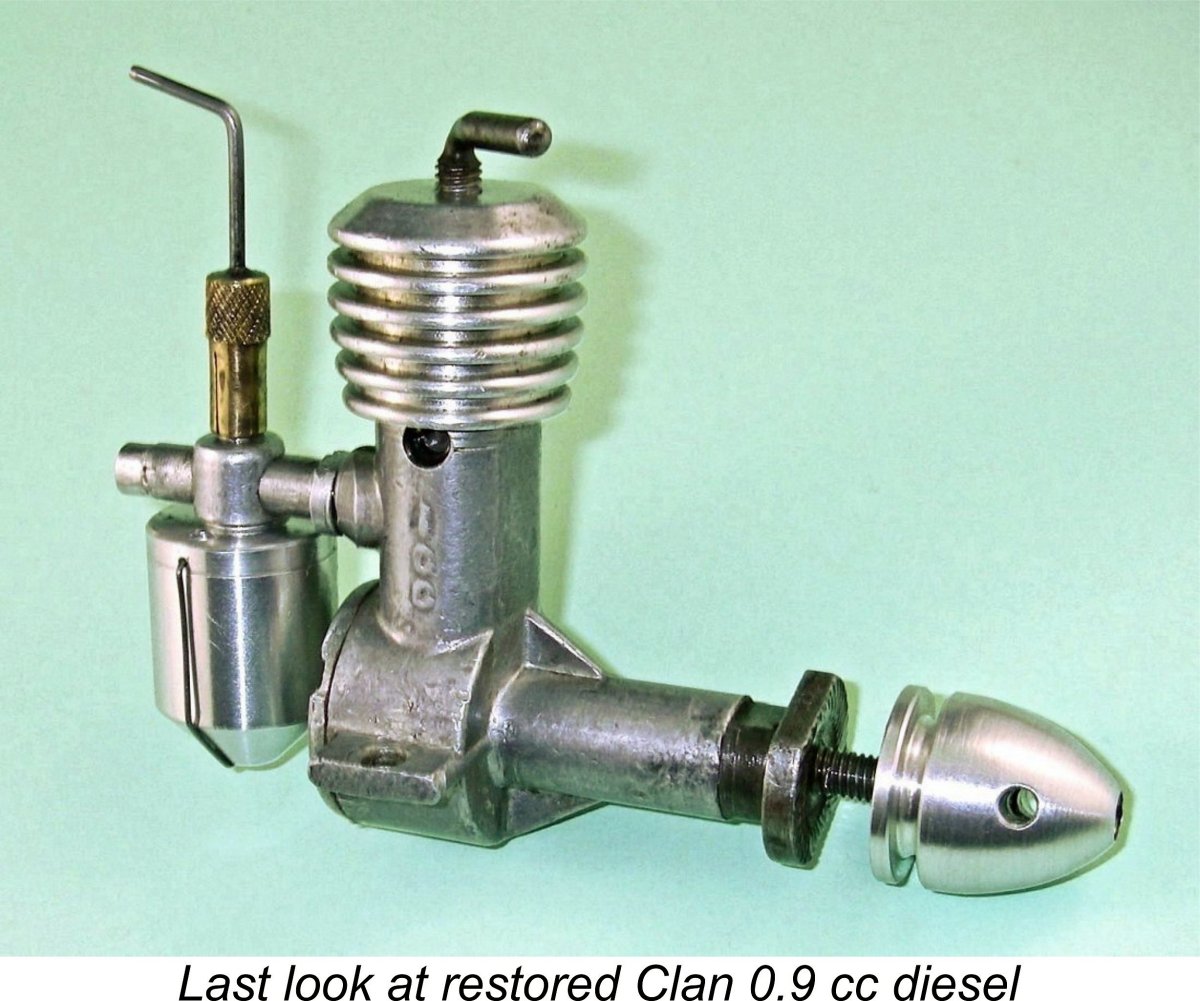 In the past, too little has been written about the Clan 0.9 cc diesel to allow for a really clear view of it in the context of its time and place. Hopefully this article will have filled that gap in the record of model engine development in early post-war Britain.
In the past, too little has been written about the Clan 0.9 cc diesel to allow for a really clear view of it in the context of its time and place. Hopefully this article will have filled that gap in the record of model engine development in early post-war Britain.